Intel Core i5-12600K vs AMD Ryzen 5 5600X and 5800X Face Off: Ryzen Has Fallen
The gaming chip showdown
The Intel Core i5-12600K vs AMD Ryzen 5 5600X and Ryzen 7 5800X rivalry is a pitched battle for dominance right in the heart of the gaming desktop PC market — the $275 to $300 price point. That might make it seem odd to throw the decidedly more expensive ~$390 Ryzen 7 5800X into the pit with the $289 Core i5-12600K and $299 Ryzen 5 5600X, but make no mistake, Intel's Alder Lake chips punch far above their pricing weight class. That's allowed them to score key upsets against higher-priced Ryzen 5000 chips in the suddenly more competitive AMD vs Intel battle.
AMD's Ryzen chips have absolutely dominated our list of Best CPUs for gaming and our CPU Benchmark hierarchy for the last year, but Intel's new design philosophy is a game-changer. As seen in our previous Intel Core i9-12900K vs Ryzen 9 5900X and 5950X faceoff, Intel's hybrid x86 Alder Lake design represents the company's most disruptive architectural shift in a decade, upsetting AMD's highest-end mainstream chips.
However, this same design is even more disruptive in the mid-range and value segments, too. Alder Lake combines big and fast Performance cores (P-cores) for latency-sensitive work with a smattering of small and powerful Efficiency cores (E-cores) that chew through background and multi-threaded workloads. Intel also baked in new next-gen connectivity tech like the DDR5 memory and PCIe 5.0 interfaces that outstrip AMD's venerable AM4 platform.
Intel is on the pricing attack with Alder Lake, perhaps looking to smash AMD's Ryzen once and for all. The $289 Core i5-12600K is $10 less than AMD's mainstream champion, the $299 Ryzen 5 5600X, and $210 less than the suggested $449 pricing for the Ryzen 7 5800X, though we often see the 5800X on sale for ~$390.
Even though Intel's chip pricing game is strong, it made a few decisions that impact overall pricing, like launching the Core i5-12600K without the affordable B- and H-series motherboards that tend to be the favorite for mainstream gamers. That means you'll have to pony up for a pricey Z690 motherboard for a mainstream chip, and DDR5 pricing continues to be a sore spot — if you can even find it in stock. The new hybrid design also has a few early performance teething pains in Windows 10.
This means the rivalry is anything but the clear-cut victory it appears to be on the benchmark charts. Below we've put the Core i5-12600K vs Ryzen 5 5600X and Ryzen 7 5800X in a six-round faceoff to see which chip takes the crown in our gaming and application benchmarks, along with other key criteria like power consumption and pricing. Let's see how the chips stack up.
Features and Specifications: Intel Core i5-12600K vs Ryzen 5 5600X and Ryzen 7 5800X
| Row 0 - Cell 0 | U.S. Price | Cores | Threads | P-Core Base/Boost | E-Core Base/Boost | TDP / PBP / MTP | DDR4-3200 | L3 Cache |
| Ryzen 7 5800X | $449 | 8P | 16 threads | 3.8 / 4.7 GHz | - | 105W | DDR4-3200 | 32MB |
| Core i5-12600K / KF | $289 (K) - $264 (KF) | 6P + 4E | 10 Cores / 16 threads | 3.7 / 4.9 GHz | 2.8 / 3.6 GHz | 125W / 150W | DDR4-3200 / DDR5-4800 | 16MB |
| Ryzen 5 5600X | $299 | 6P | 12 threads | 3.7 / 4.6 GHz | - | 65W | DDR4-3200 | 32MB |
Intel's hybrid architecture brings what we would normally consider 'odd' thread arrangements. That's because the P-cores are hyper-threaded, while the E-cores only have a single thread.
As a result, the $289 10-core 12600K comes with six threaded P-cores that operate at 3.7 / 4.9 GHz and four E-cores that run at 2.8 / 3.6 GHz, for a total of 16 threads. That's a 33% increase in the number of threads over the Core i5-11600K. The chip also has 20MB of L3 and 9.5MB of L2 cache.
The 12600K comes with the integrated UHD Graphics 770 engine with 32 EUs that run at a 300 MHz base and boost to 1,450 MHz. That's a big advantage over the graphics-less 5600X and 5800X. If you don't plan to use a discrete GPU, Intel wins by default. Intel also has the Core i9-12600KF, an identical chip that lacks the integrated graphics engine, for $264. That might not sound like much of a discount, but a $25 price reduction is tempting if you plan to use this chip for a gaming rig that doesn't need integrated graphics — you'll end up paying $35 less than you would for the similarly graphics-less Ryzen 5 5600X.
Intel has replaced its old TDP rating and now uses a Processor Base Power (PBP) value (PL1) in place of TDP and a secondary Maximum Turbo Power (MTP) value that represents the highest power level during boost activity (PL2). You can read more about that change here.
The 12600K comes with 125W PBP (base) and 150W MTP (peak) power ratings, but be aware that Intel changed its default boost duration for all K-series chips to an unlimited value. This means the 12600K can always operate at the 150W MTP when under load, but actual power consumption will vary by application.
The 12600K goes toe-to-toe with the 6-core, 12-thread Ryzen 5 5600X that has long been the favorite for enthusiasts because of its incredible blend of pricing and performance. The 12600K also rivals the 8-core 16-thread Ryzen 7 5800X that has been a tough sell in the face of its closely-priced Ryzen 5000 siblings. These chips come with 65W and 105W TDP ratings, respectively, 32MB of L3 cache, and have only high-performance cores. Both chips support DDR4-3200 memory and the PCIe 4.0 interface.
Like the rest of the Alder Lake chips, the Core i5-12600K has the most cutting-edge connectivity options that money can buy. All Alder Lake chips support DDR4-3200 or up to DDR5-4800 memory (odd DDR5 population rules apply). Alder Lake chips also expose up to 16 lanes of PCIe 5.0 and an additional four lanes of PCIe 4.0 from the chip for M.2 storage. These new technologies add cost to the Z690 motherboards that house the chips, and the current pricing for DDR5 memory is eyewatering. However, Intel's Z690 supports DDR4, too, but it appears that you'll only find DDR4 support on lower-end Z690 boards. Intel hasn't launched the value-centric B- and H-series chipsets yet, so platform pricing will be high for now. That's particularly painful down at the 12600K's price point, but it is noteworthy that there is quite a pricing spread between the flagship and bottom-of-the-barrel Z690 options.
Intel also added 12 lanes of PCIe 4.0 to its chipset (in addition to its 16 lanes of PCIe 3.0), and now offers a total of 28 lanes. Intel has also widened the DMI connection between the chip and the chipset, which now serves up twice the throughput. The increased DMI throughput is also beneficial for Z690's bolstered connectivity options, like the new second USB 3.2 Gen 2x2 20 Gbps connection (other new features are listed here).
The 5600X comes with a bundled Wraith Stealth cooler that will serve basic needs, while the Core i5-12600K comes without a cooler. The 12600K comes with graphics, or as a graphics-less variant that's $35 less than the 5600X, helping offset that cost delta.
Winner: Intel
AMD's AM4 platform has soldiered on for five long years (and counting), earning the company plenty of cachet with enthusiasts because they didn't have to upgrade motherboards with every new chip generation. However, even though we did see the move from PCIe 3.0 to 4.0 a few years ago, the AM4 platform has restricted forward progress on the connectivity front — there's only so much you can do with a fixed number of pins.
As such, Intel's Z690 platform has a clear connectivity advantage: With DDR5 and PCIe 5.0 on the menu, AMD's aging AM4 platform finds itself simply outclassed. Intel's new features do make for more expensive motherboards, though, and the lack of B- and H-series boards at launch stings. Fortunately, there are options for DDR4 variants to save you at least some coin.
Given its new hybrid architecture with two types of cores, Intel's core counts aren't directly comparable to AMD's due to their different capabilities. Our performance results will dictate the value of the overall designs.
Get Tom's Hardware's best news and in-depth reviews, straight to your inbox.
The Core i5-12600K comes with integrated graphics by default, though you can sacrifice those for a lower price point. Meanwhile, you'll have to look to AMD's Ryzen 7 5700G APUs if you want integrated graphics.
Gaming Benchmarks and Performance: Intel Core i5-12600K vs Ryzen 5 5600X and Ryzen 7 5800X
This article is an overview of our much more in-depth testing in our Intel Core i9-12900K and Core i5-12600K review. We're focusing on our Windows 11 test results in this article, but be aware that you could encounter odd performance in some cases with Windows 10. We have the full details and Windows 10 testing in our review.
Below you can see the geometric mean of our gaming tests with the Core i5-12600K vs the Ryzen 5 5600X and Ryzen 7 5800X at 1080p and 1440p, with each resolution split into its own chart. As per usual, we're testing with an Nvidia GeForce RTX 3090 to reduce GPU-imposed bottlenecks as much as possible, and differences between test subjects will shrink with lesser cards or higher resolutions.

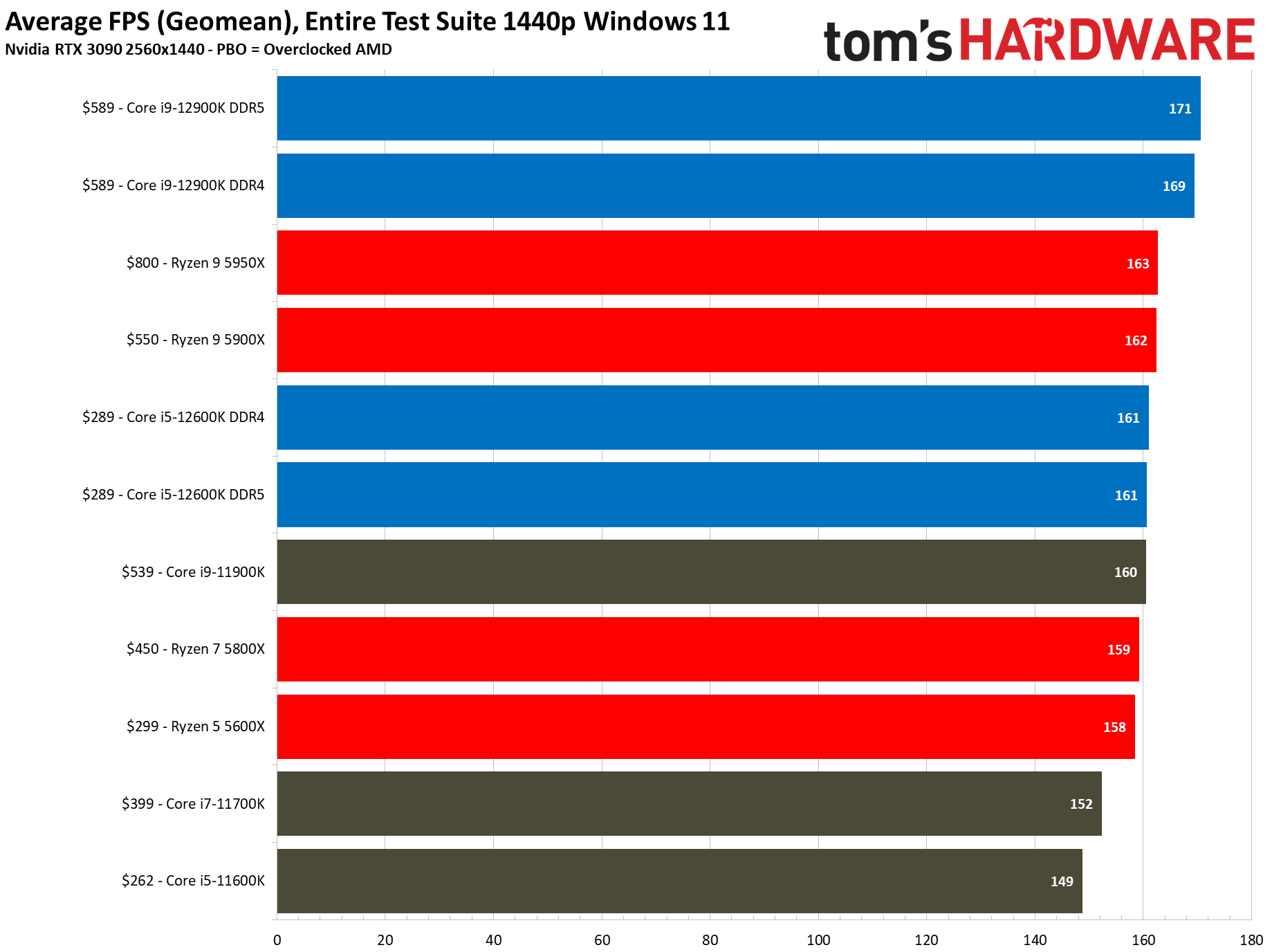
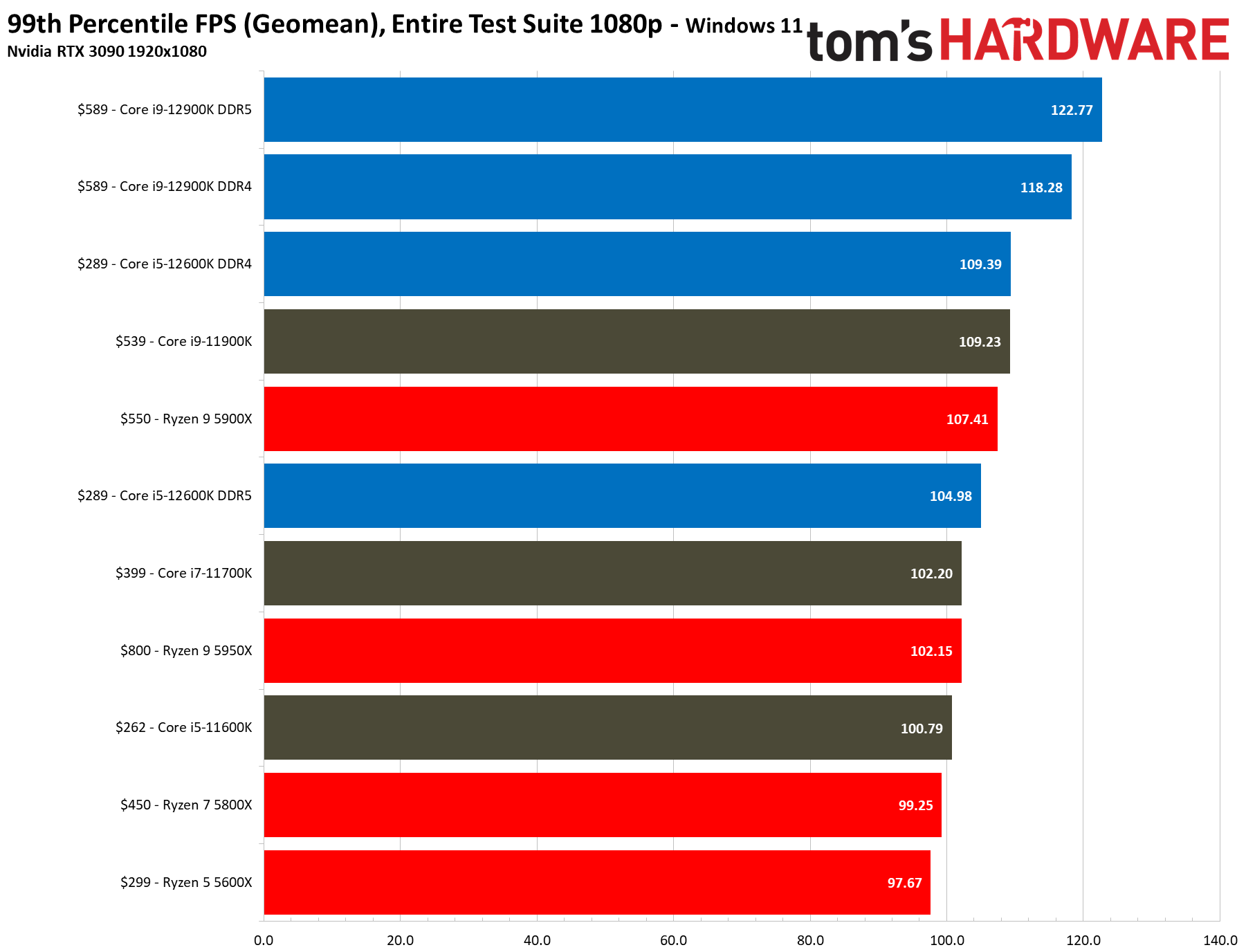
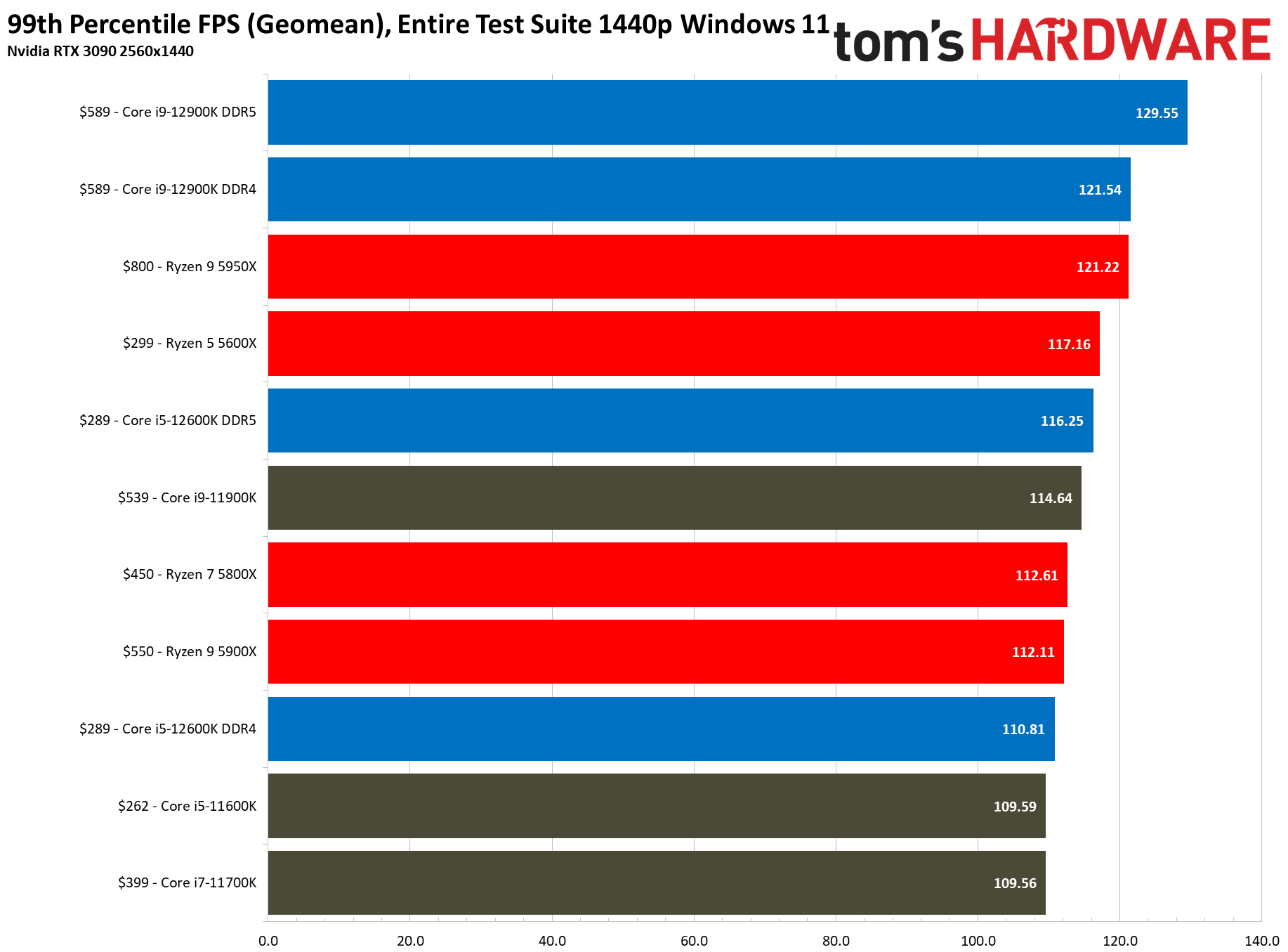
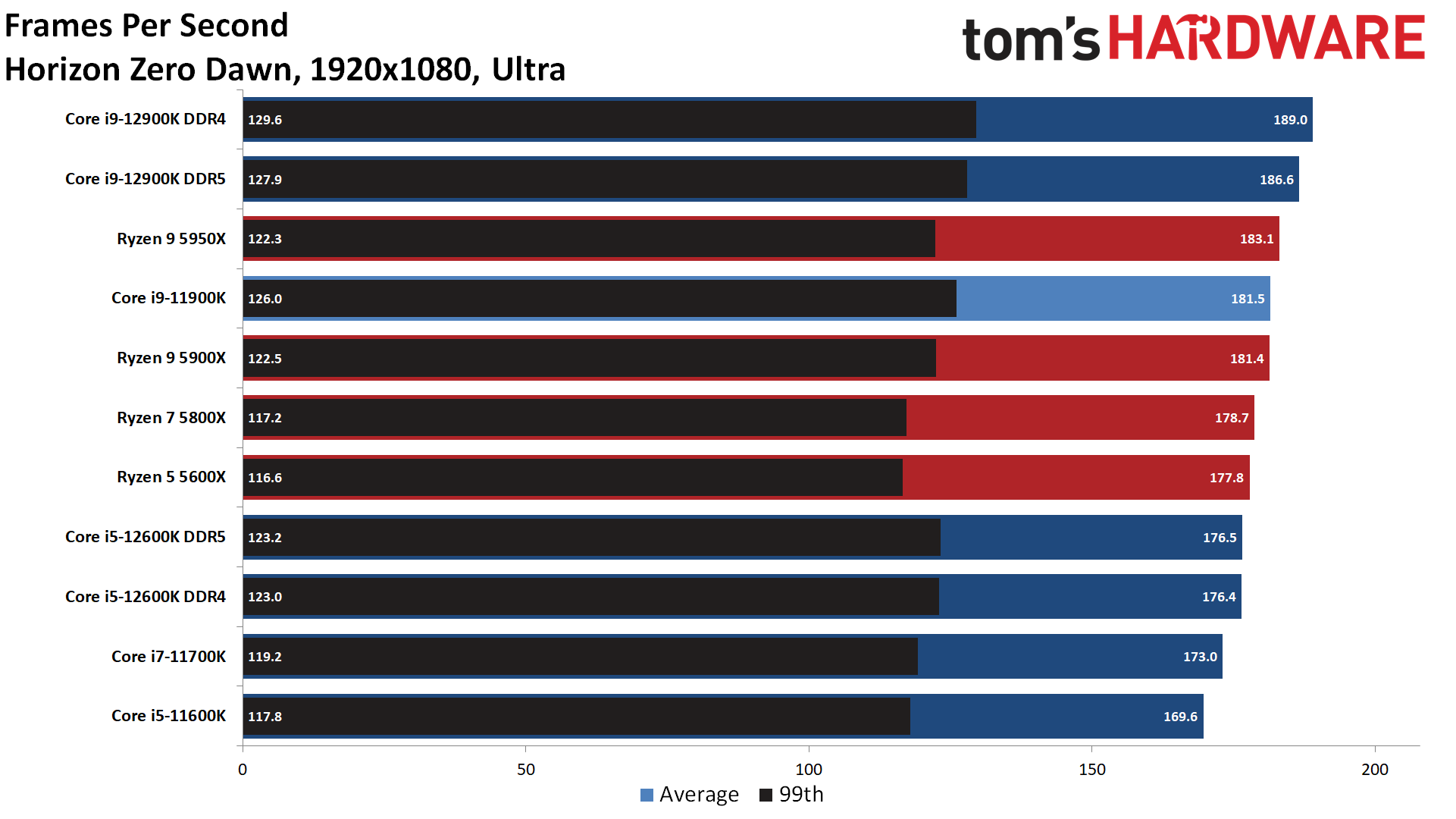
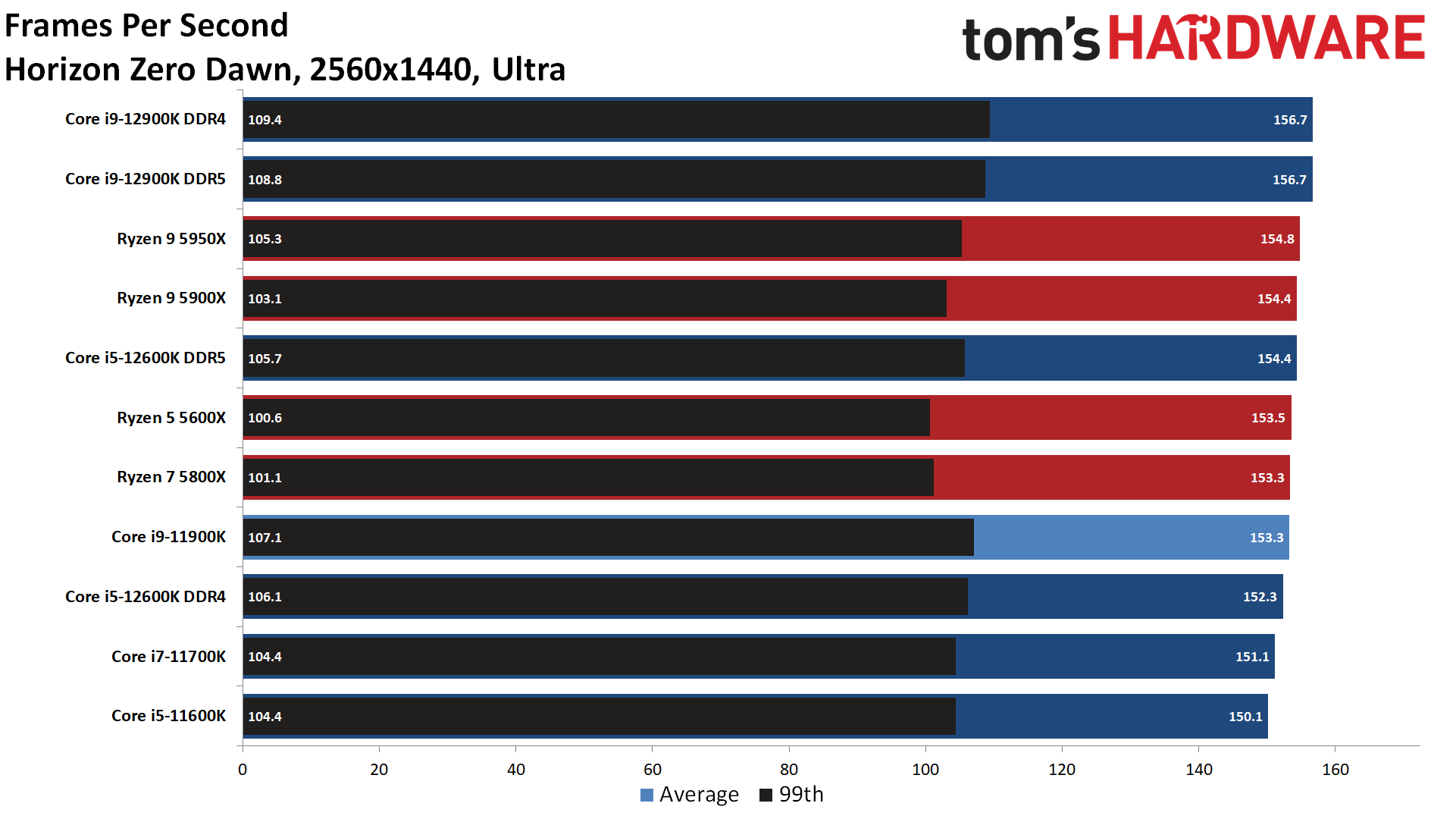

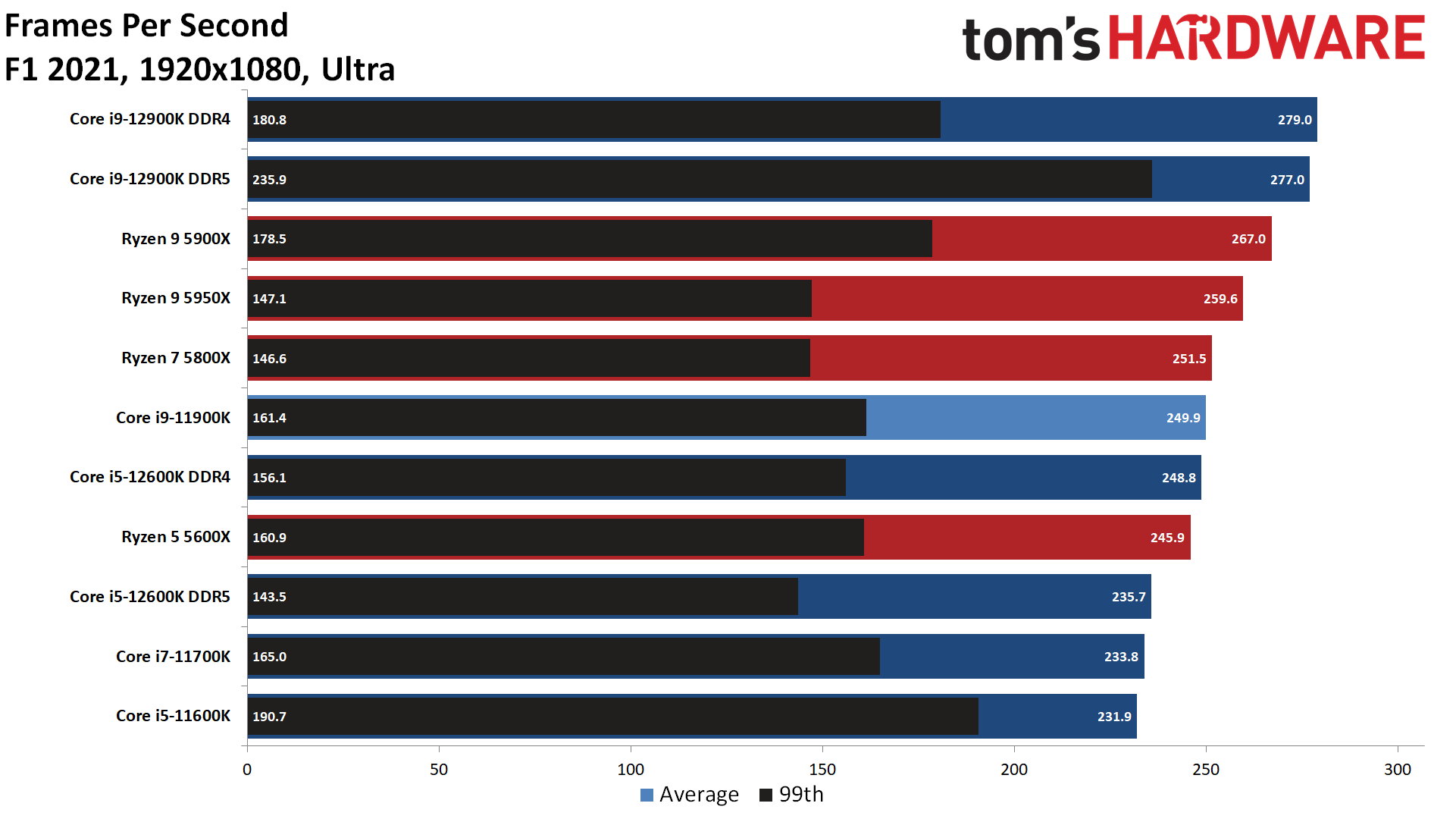
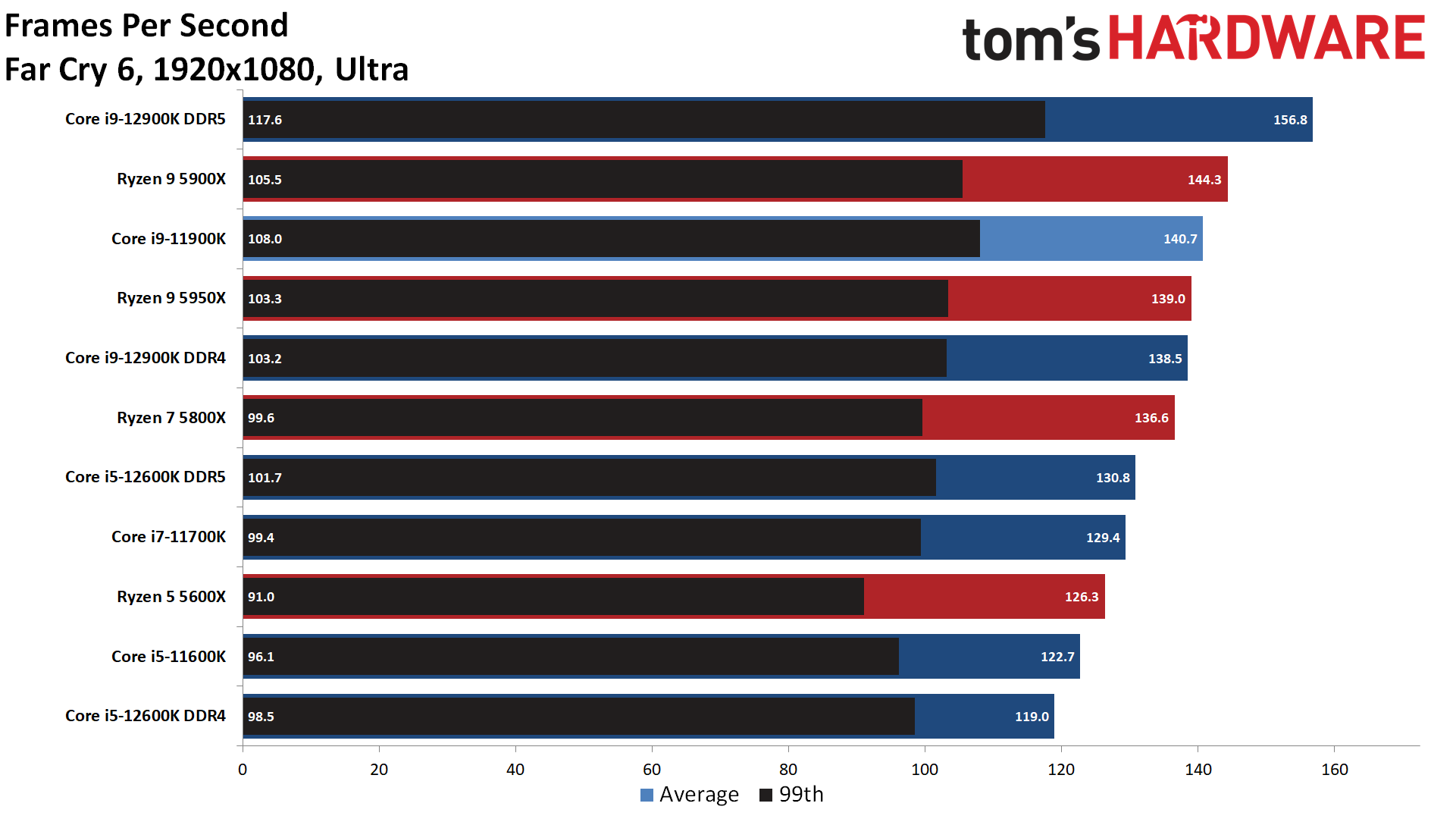

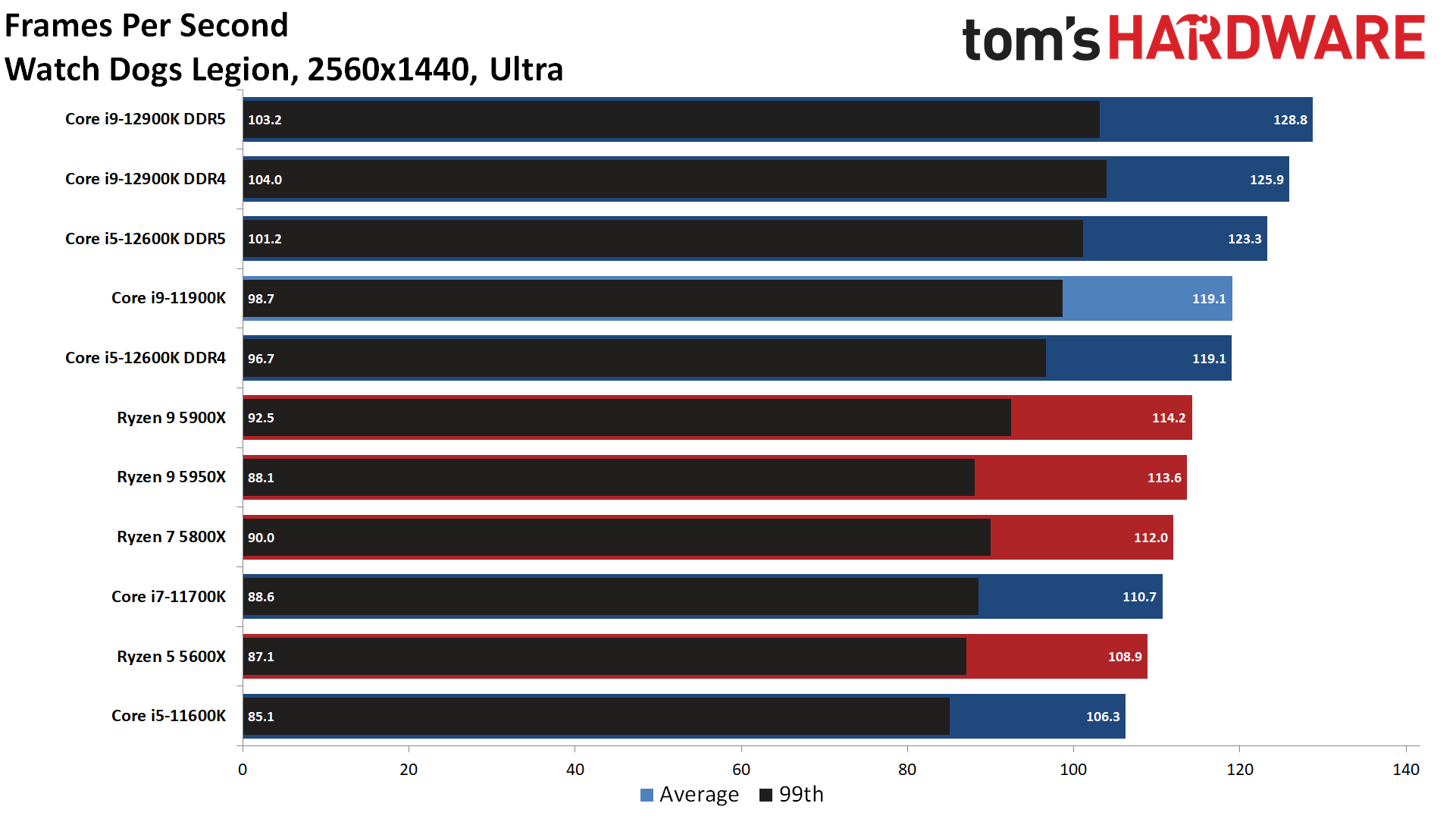
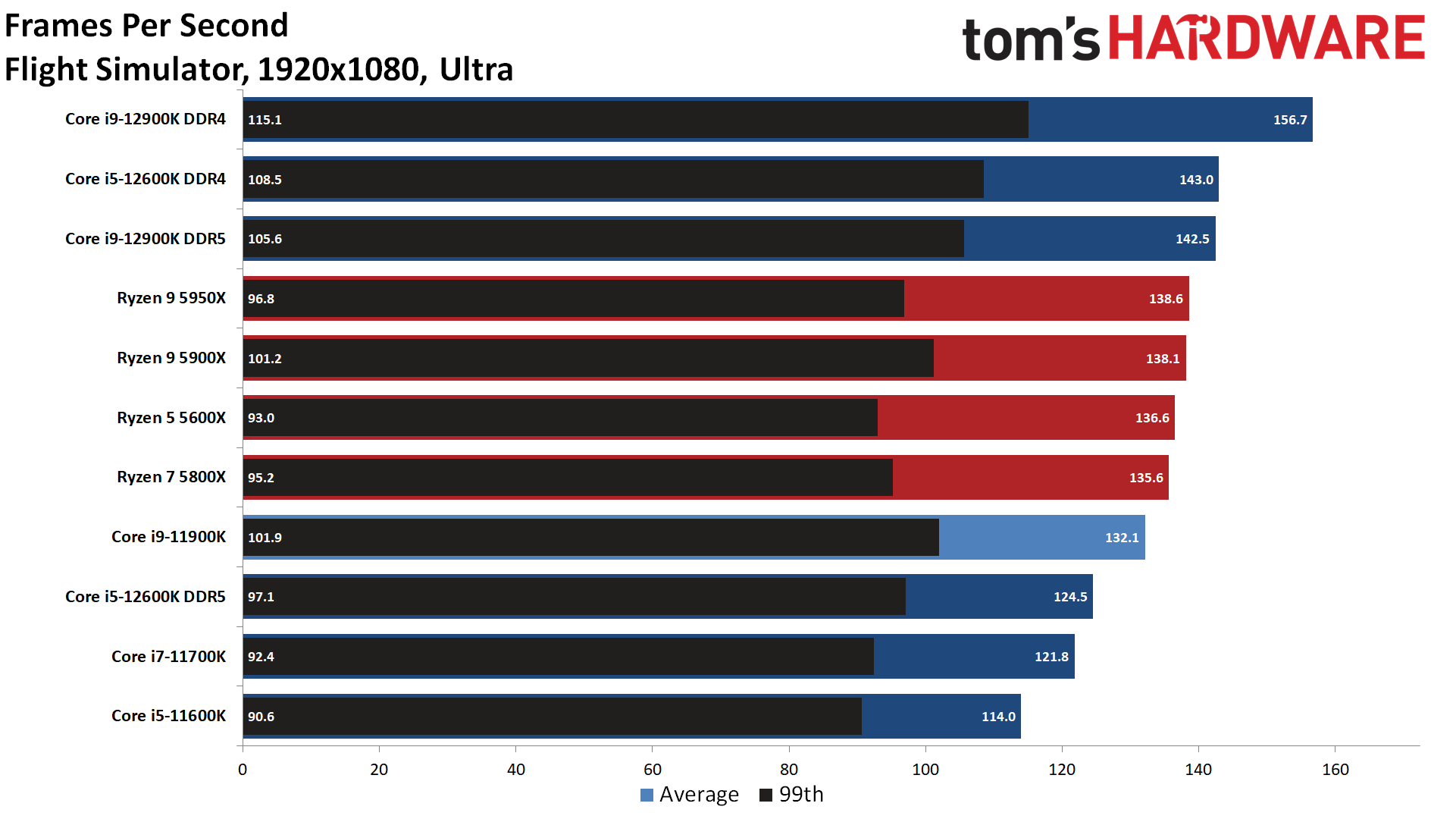

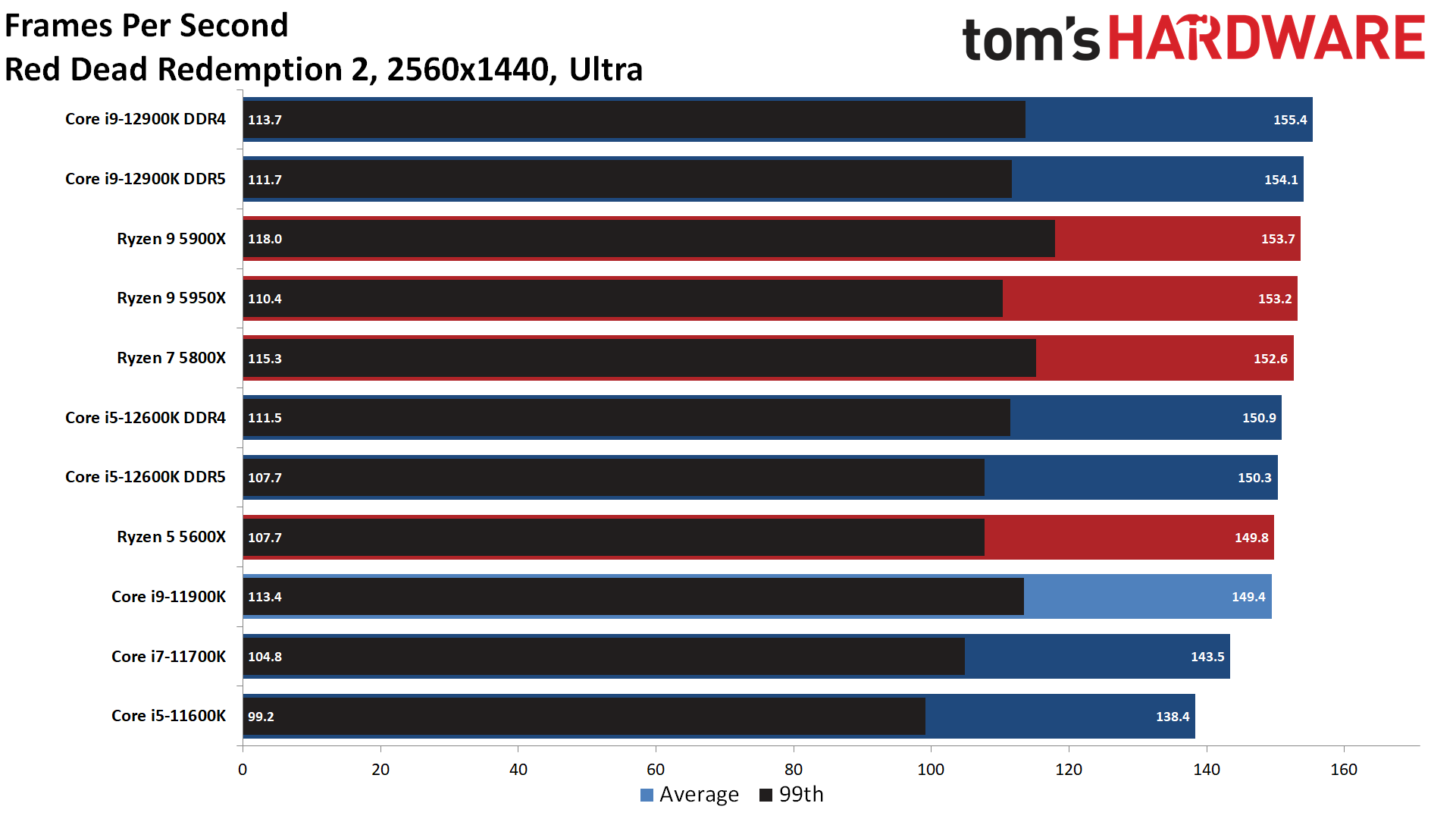
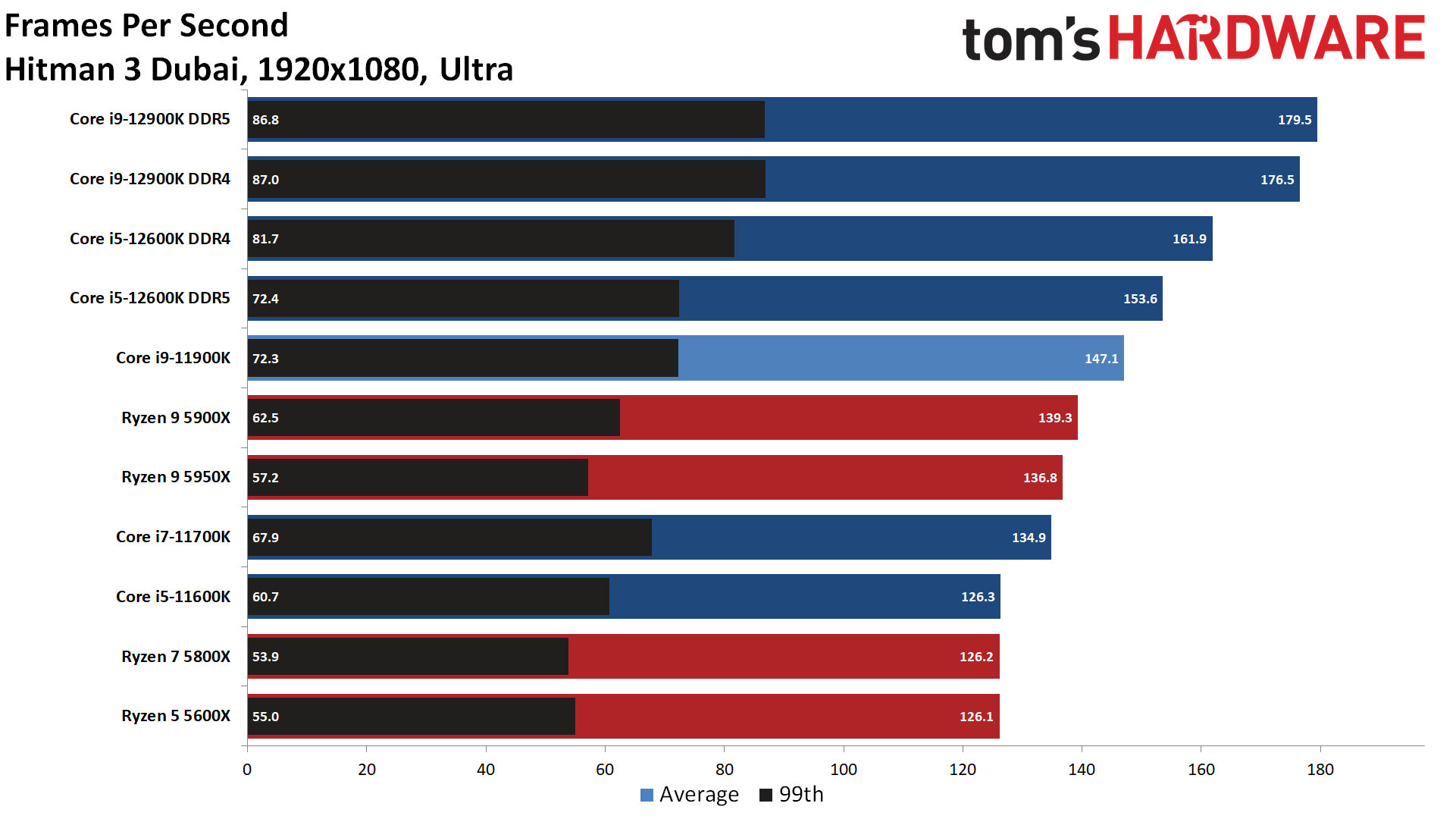

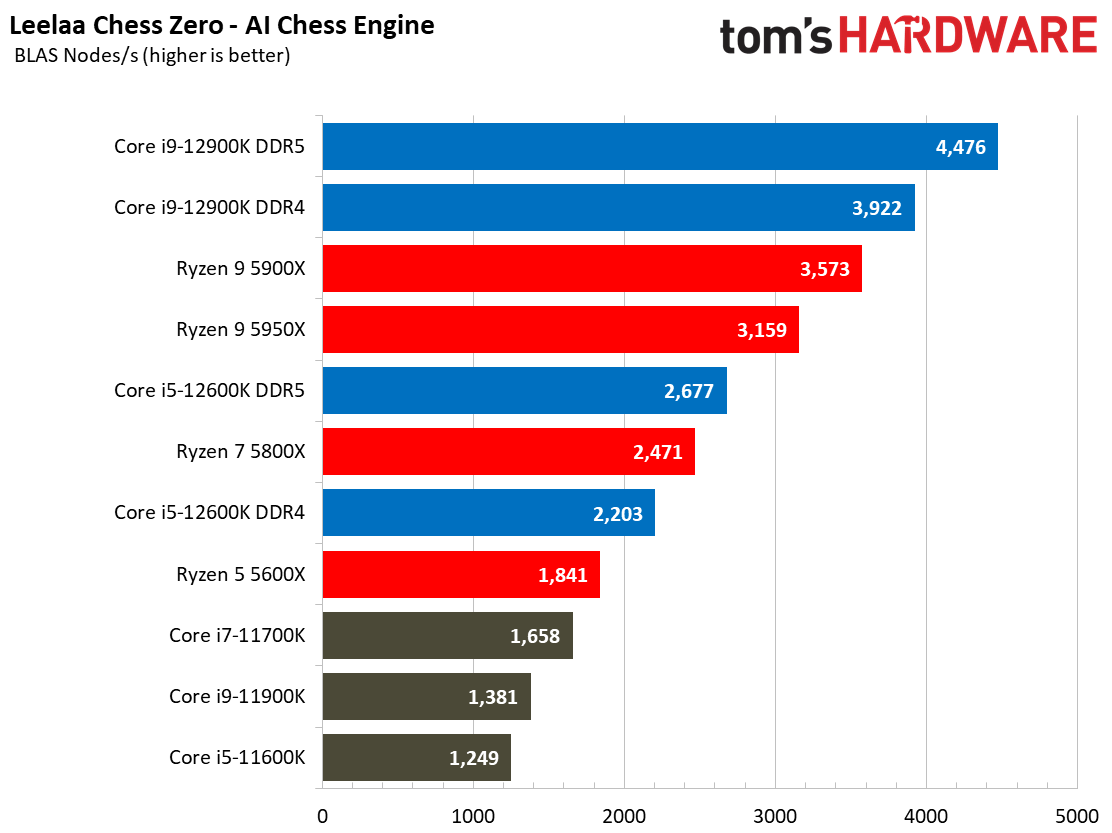


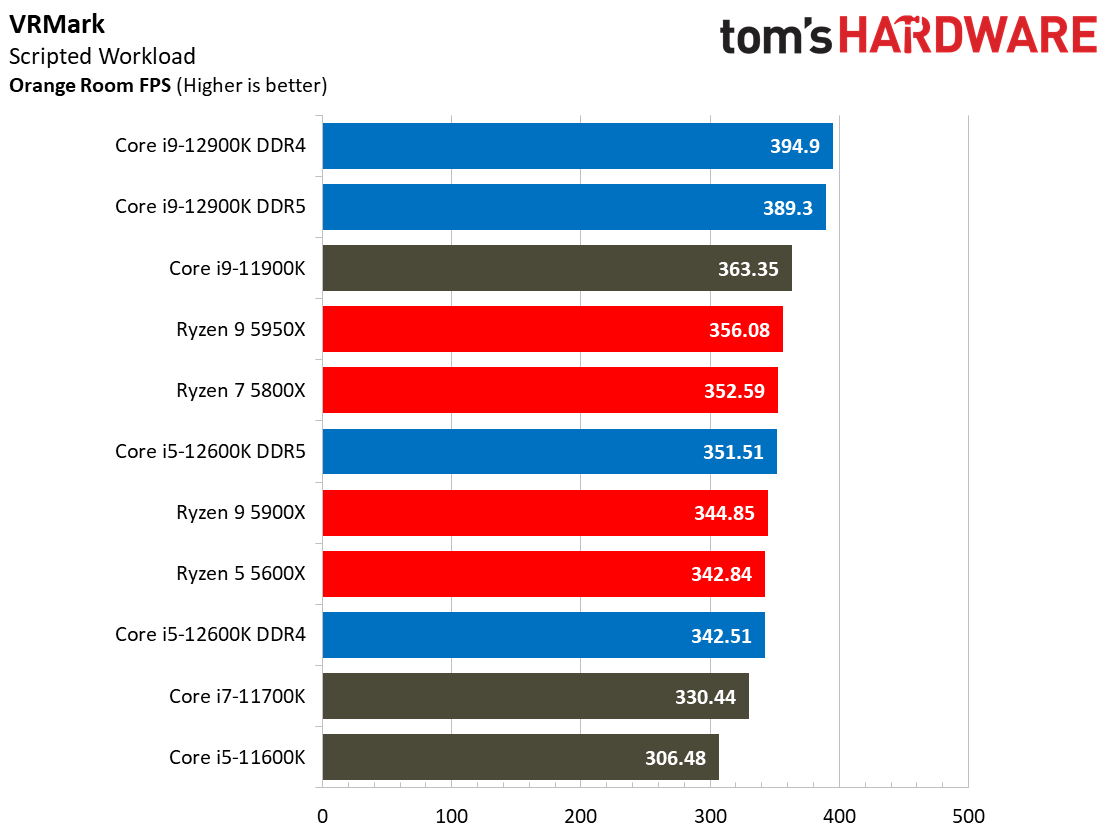


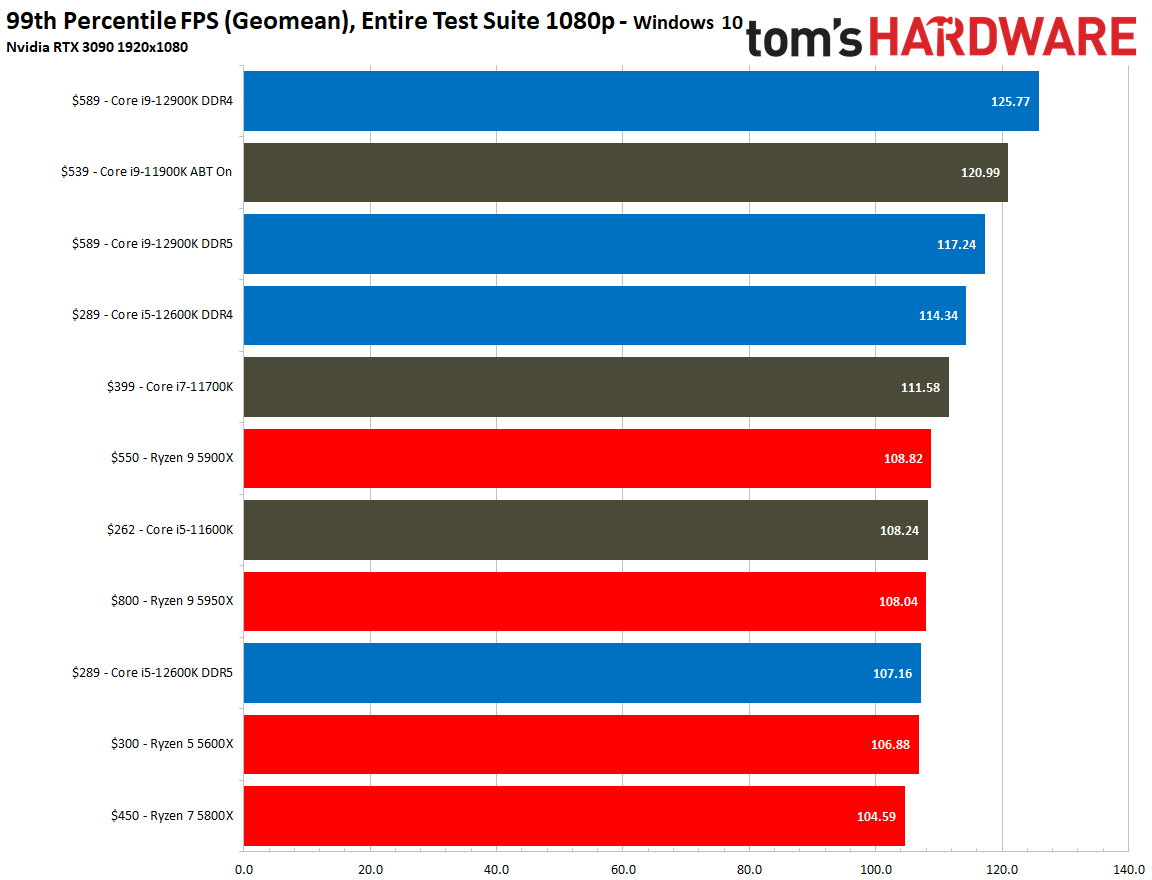
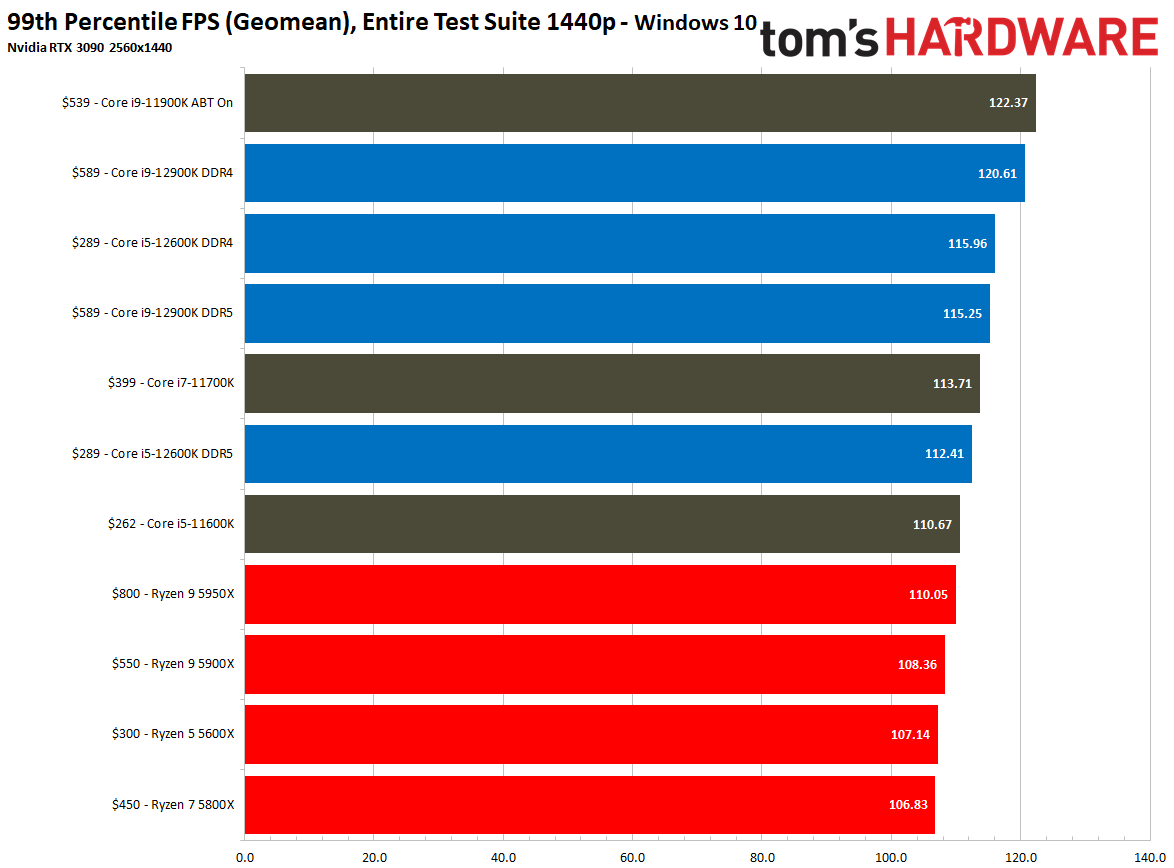
In Windows 11, the $289 Core i5-12600K with DDR5 memory is ~2.7% faster than the $299 Ryzen 5 5600X, but that gap widens slightly with less expensive DDR4 memory. The Core i5-12600K also effectively ties the Ryzen 7 5800X, but for ~$100 less. And that's with both the DDR4 and DDR5 memory configurations.
Naturally, moving over to 1440p pushes the bottleneck to the GPU, so the difference between the chips shrinks tremendously. Here the Core i5-12600K effectively ties the 5600X and 5800X, so you might pay closer attention to overall pricing if you plan to game at higher resolutions. Gamers with lower-resolution panels with high refresh rates will benefit more from Alder Lake's faster frame rates.
Flipping through the 99th percentile charts shows larger deltas between the chips, but we have to view those with caution. Windows 11 is still a bit raw and seems to suffer from more framerate variability than Windows 10. This could stem from yet-to-be-updated game code, the relatively new GPU drivers for Windows 11, or some other combination of factors that could improve in the future.
Intel's E-cores could come in handy for gamers and streamers alike. The Intel-sponsored Hitman 3 offloads low-priority tasks like audio and physics to the small cores, giving the chips a big advantage. We could see more games adopt that type of tuning in the future. In addition, Intel says that streaming your gaming session with OBS, which runs on the smaller E-cores, can result in 84% more fps than its prior-gen chips. We're working on putting that to the test, but it does show that the E-cores could have a big impact on gaming as more games and applications add support.
We also included our overall gaming results with Windows 10 at the end of the album. We used a different set of games from our previous Windows 10 test suite, and here DDR4 memory yielded better gaming results than DDR5.
As a result, the 12600K was roughly 8% faster with DDR4 than with DDR5, which is the difference between beating the Ryzen 5 5600X or losing to it. That could be from the motherboard firmware on the board we used for testing, or just some tuning that's needed in Windows 10 to extract the most from the higher-bandwidth memory. Conversely, it could just be that the higher latency of DDR5 has a bigger impact on Windows 10, but that could improve as DDR5 matures.
The AMD vs Intel gaming competition is closer now, with some games favoring one architecture over the other. As such, it's best to make an informed decision based on the types of games that you play frequently. Be sure to check out the individual tests in the above album. In either case, Intel holds the lead.
Winner: Intel
The Core i5-12600K speeds past AMD's Ryzen 5 5600X and the Ryzen 7 5800X during almost all of our gaming tests in Windows 10 and 11, but there is a caveat: The 12600K led with DDR4 memory in both operating systems, but our DDR5 test system didn't respond as well in Windows 10. In either case, the 12600K led convincingly in 3 of the four configurations, which is impressive given its price point.
Of note: The Denuvo DRM falsely identified Intel's E-cores as a separate system, and thus ~20 Denuvo-enabled game titles currently don't work with Alder Lake chips. You can read about the simple fix and find the impacted games here. Denuvo says that all affected games will be patched soon.
Application Performance: Intel Core i5-12600K vs Ryzen 5 5600X and Ryzen 7 5800X
We're focusing on Windows 11 application test results for this article, but be aware that we encountered subpar performance in Windows 10 with some of the programs that worked perfectly in Windows 11. These problems arise due to a lack of software optimizations for hybrid architectures.
There are methods to correct those issues in Windows 10, but it could require some manual adjustment until more patches arrive from software vendors. Aside from the odd performance in the Handbrake x264, y-cruncher, Corona and POV-Ray tests, our comparative Windows 10 performance results largely mirrored what we see in Windows 11. Head to our review for more detailed information.
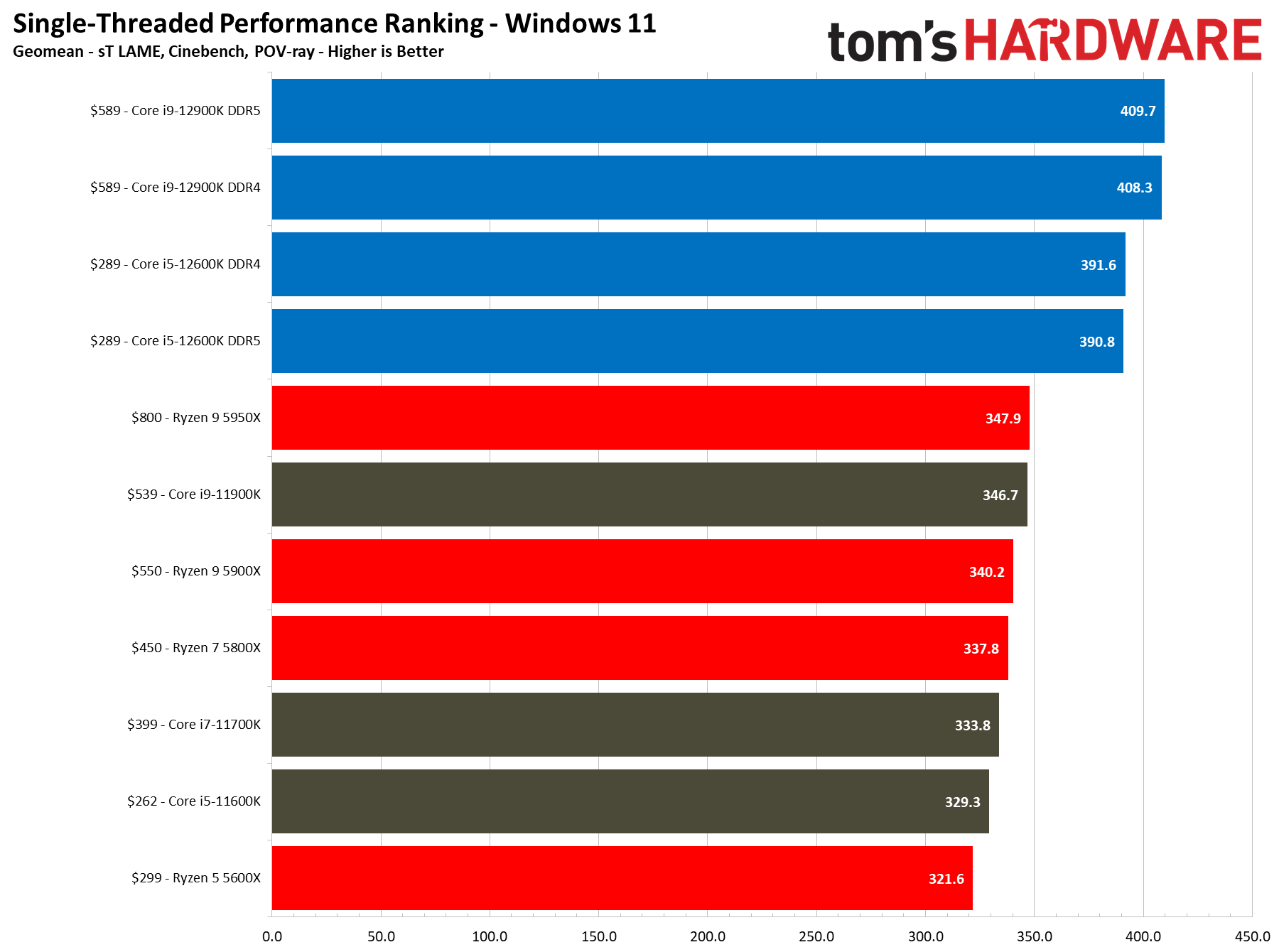

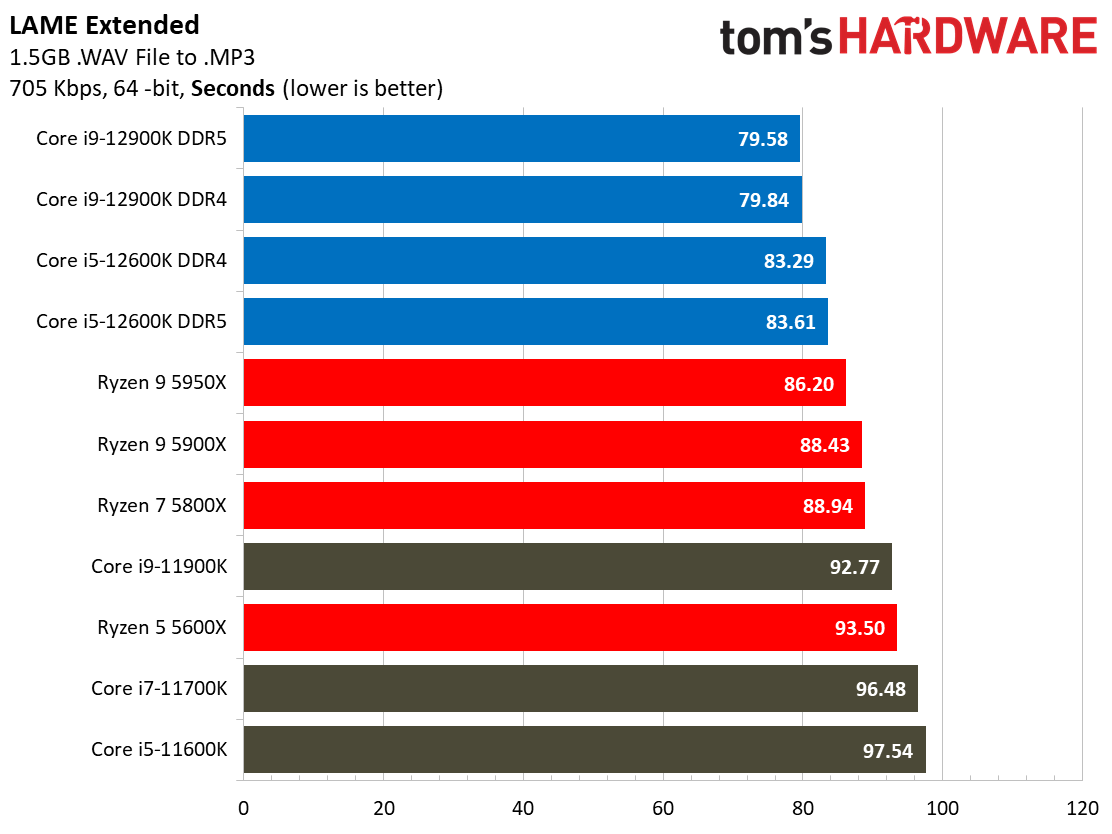
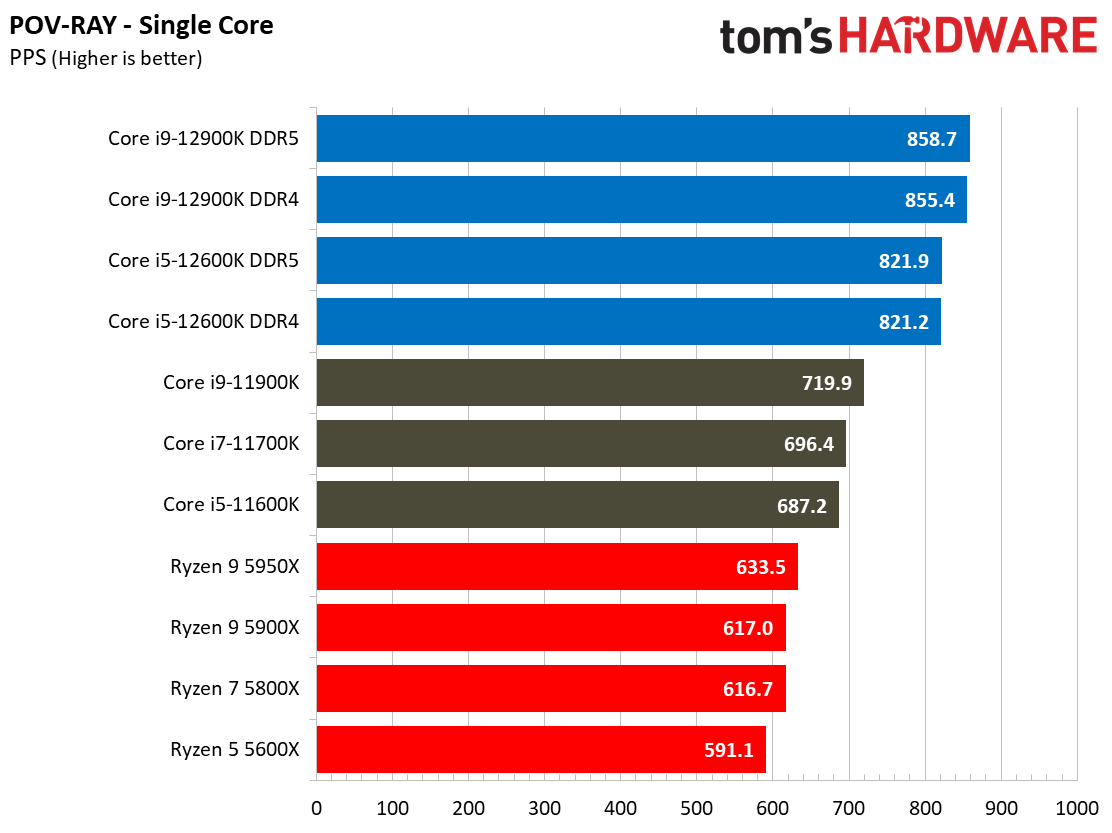
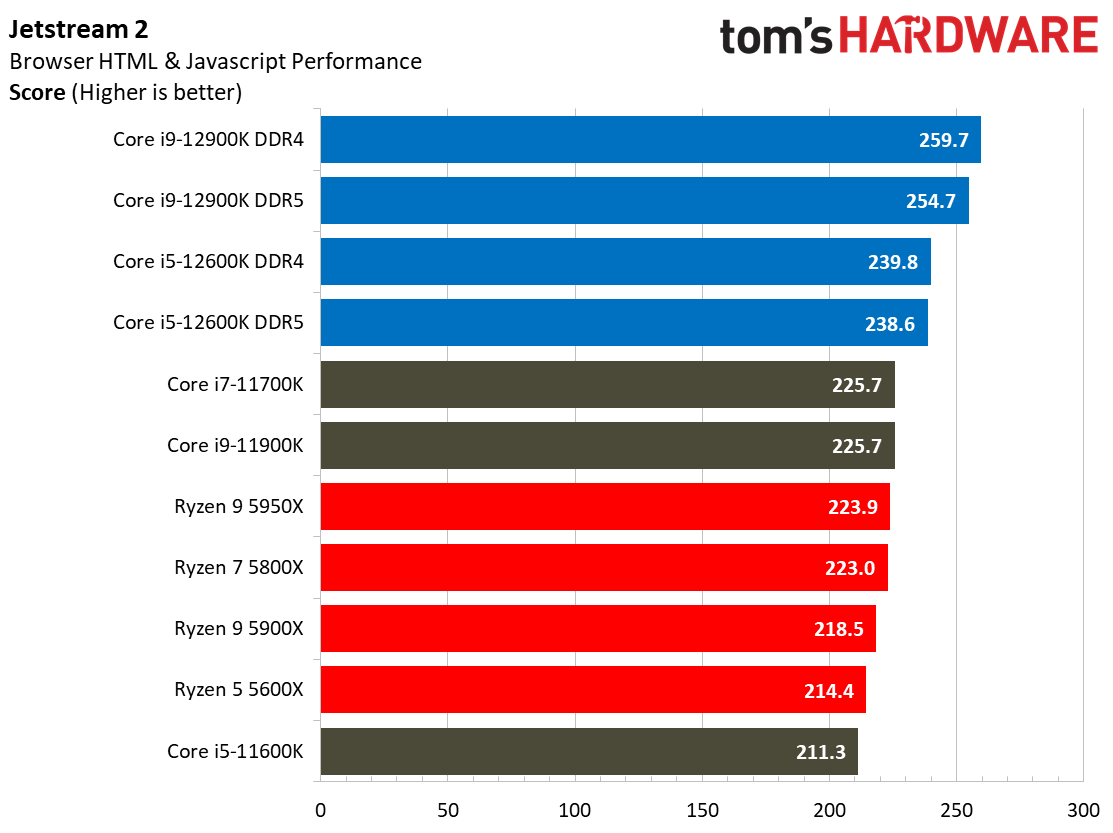

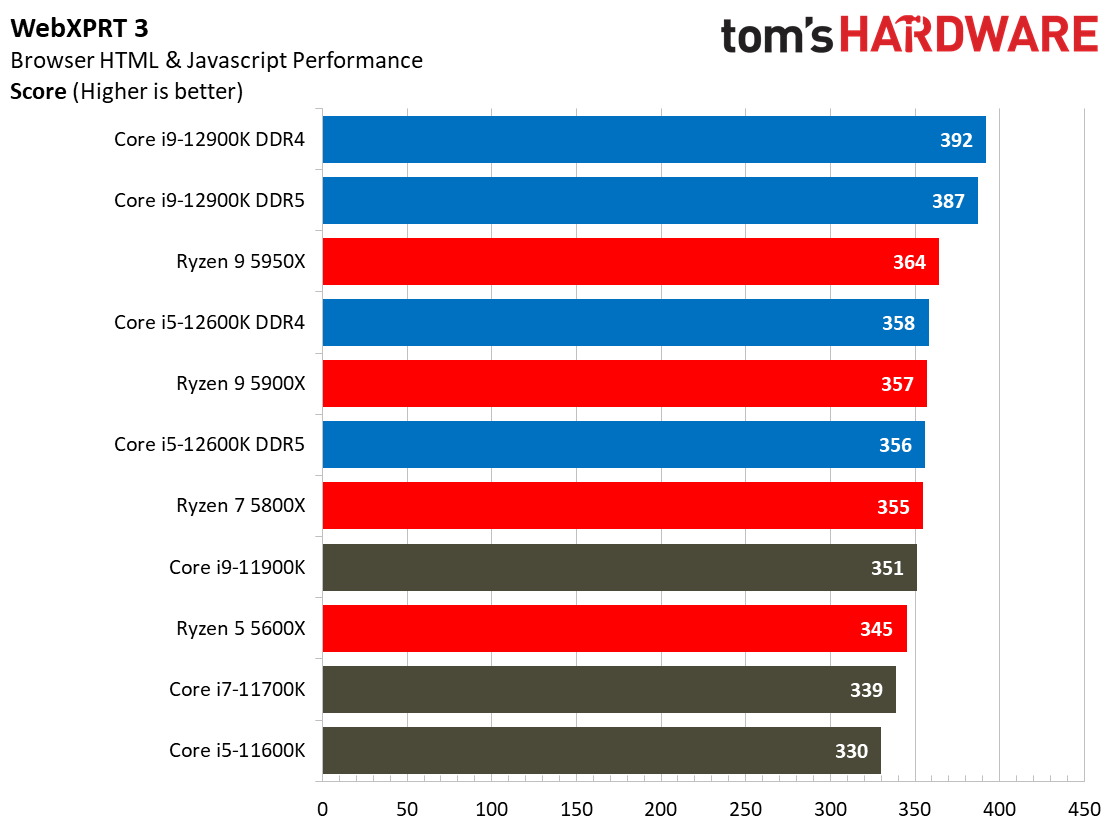
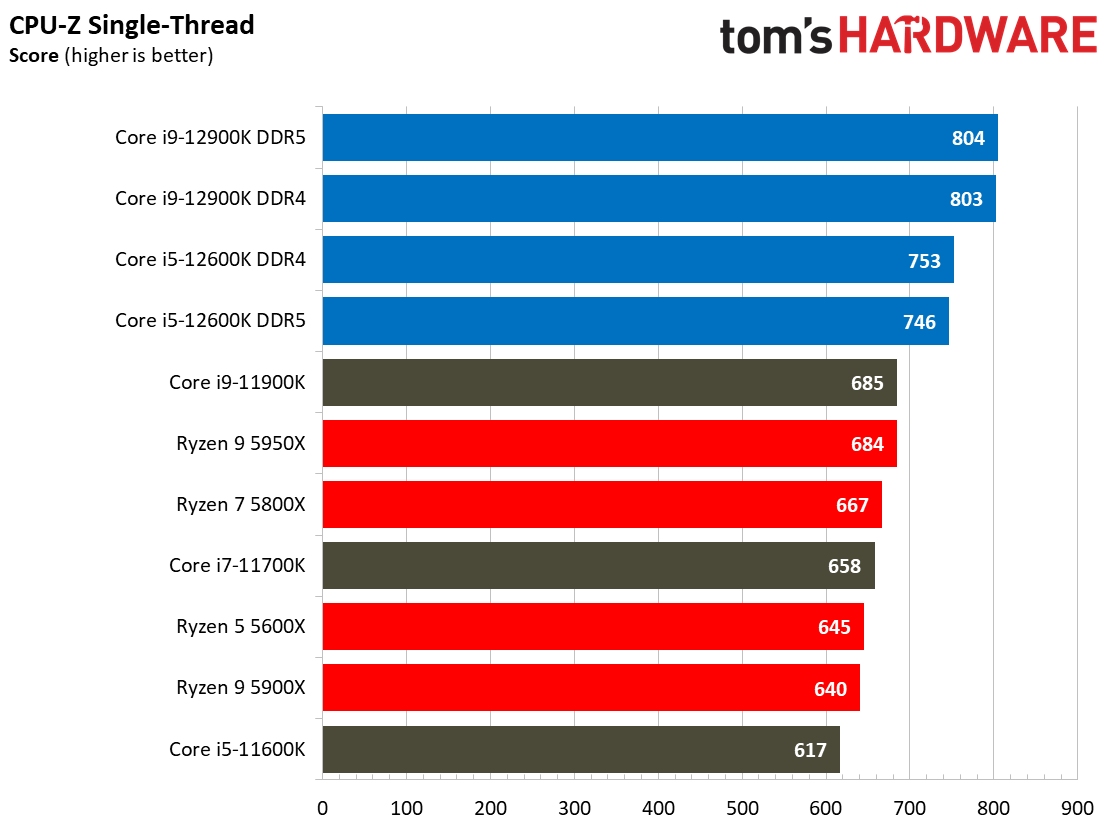


We can boil down productivity application performance into two broad categories: single- and multi-threaded. The first slide above shows the geometric mean of performance in several of our most important tests in each category, but be sure to look at the expanded results below.
The deltas in favor of Alder Lake are plenty convincing — the Core i5-12600K is 21% faster than the Ryzen 5 5600X and 15% faster than the Ryzen 7 5800X in the single-threaded tasks listed in the chart title. That's impressive.
Naturally, those big performance deltas won't carry over to every type of workload, but flipping through the album reveals that the Core i5-12600K delivers amazing performance for its price point. The chip regularly beats the Ryzen 9 5950X and 5900X, not to mention the much less-expensive chips we're focusing on, the 5600X and 5800X. The Core i5-12600K trailed the 5800X in a single test (application start-up) but won every other benchmark.
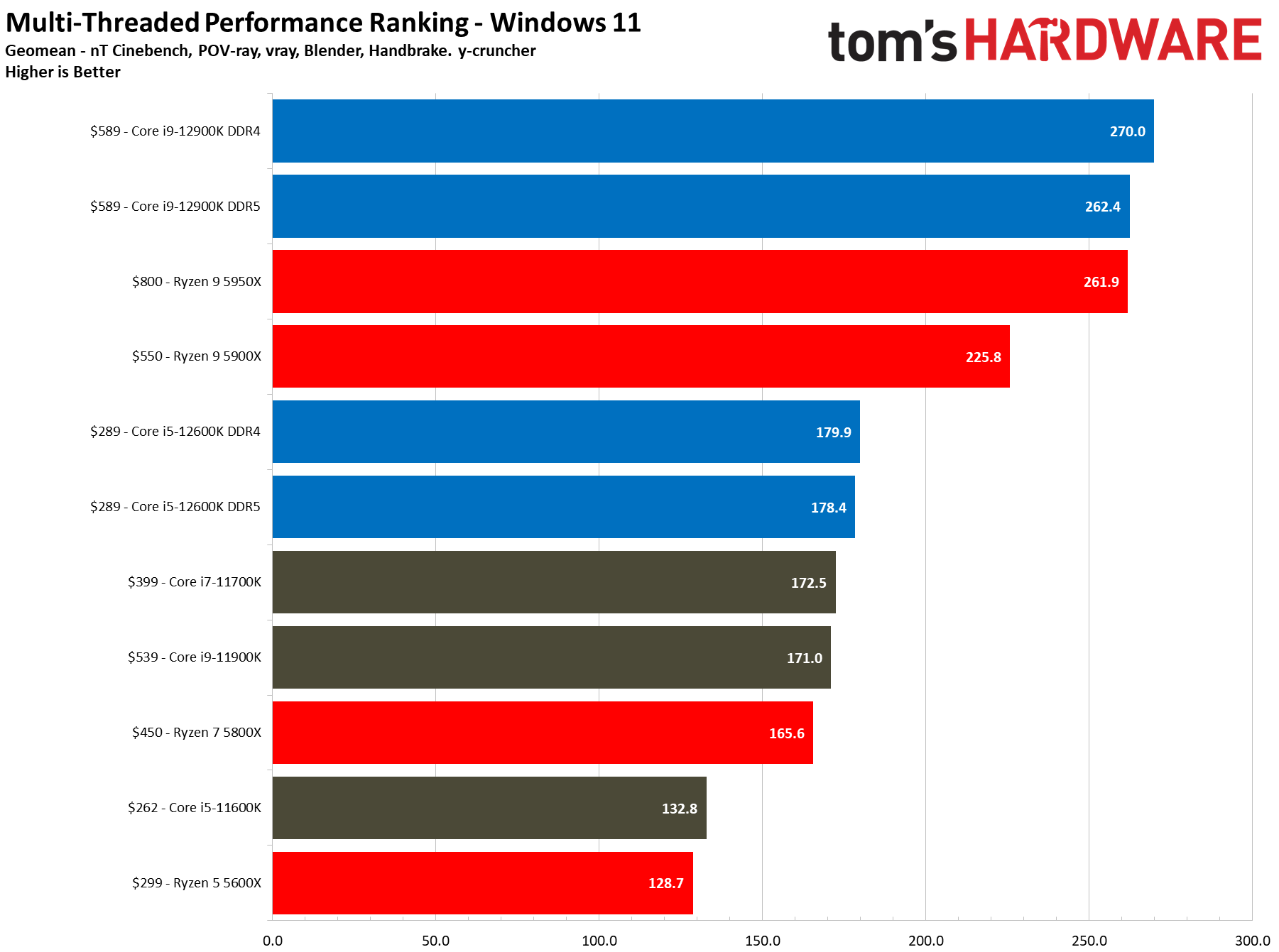
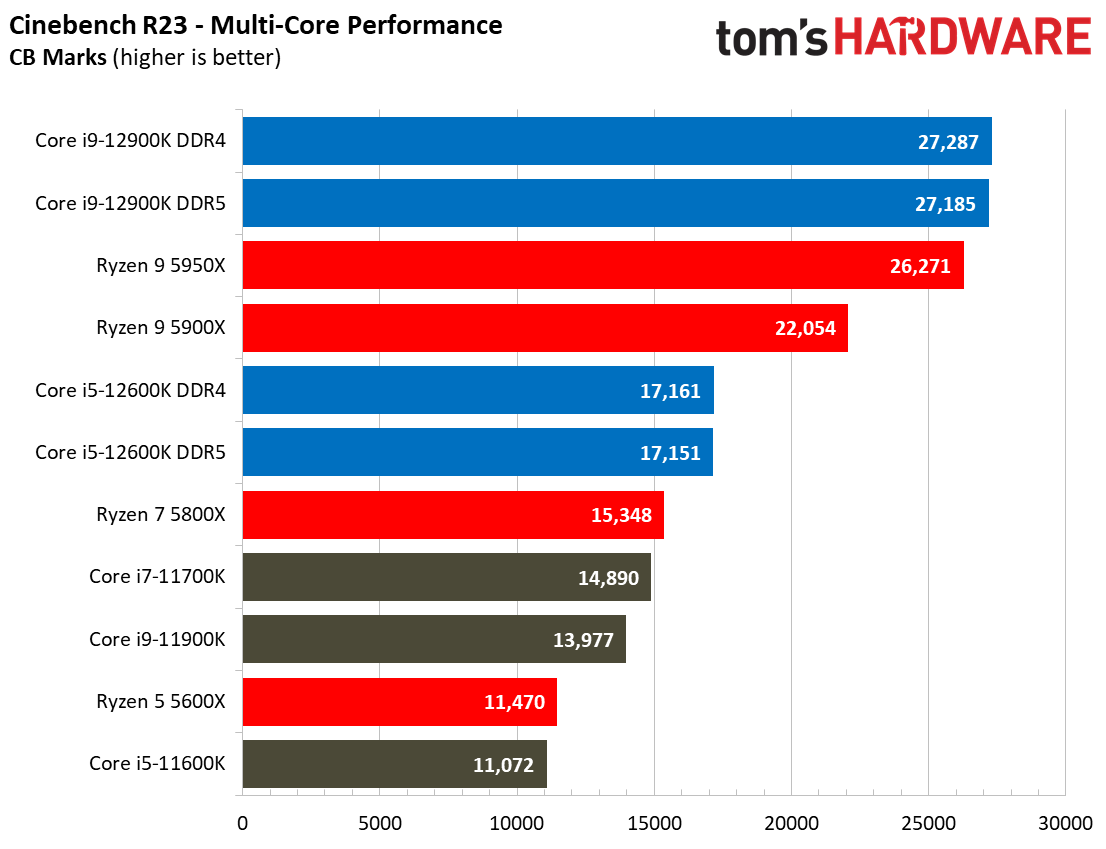
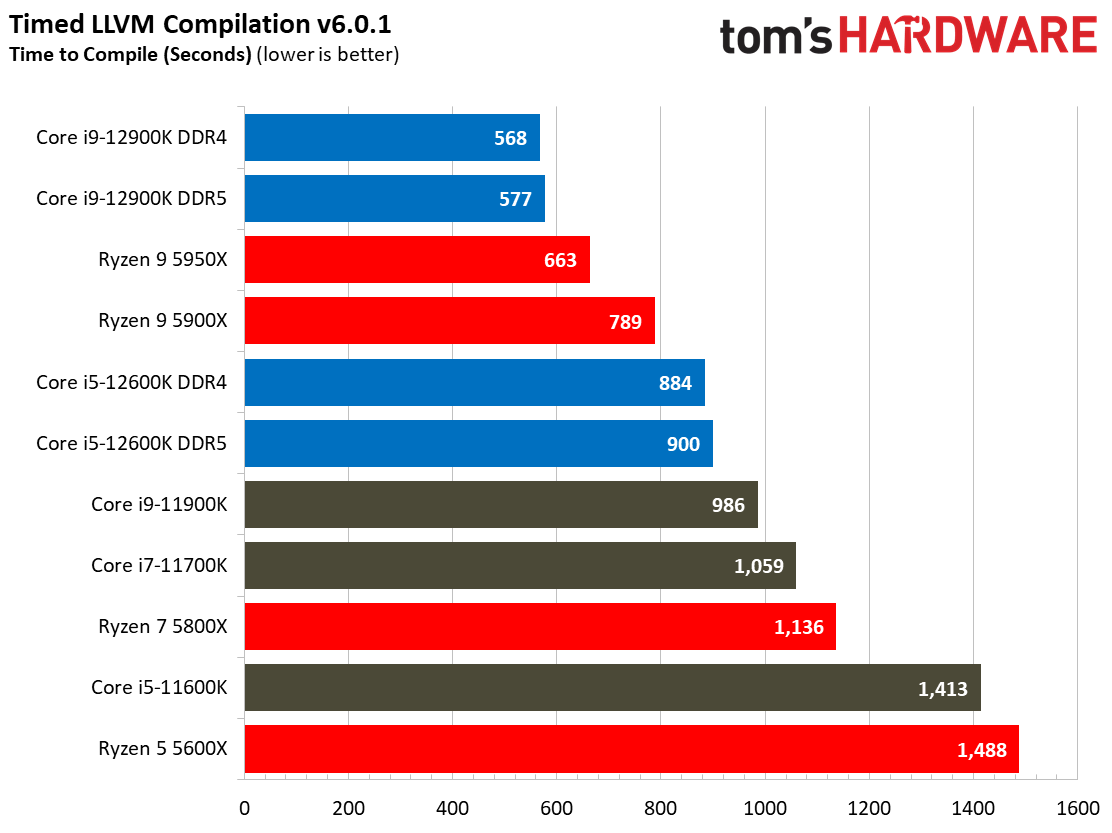

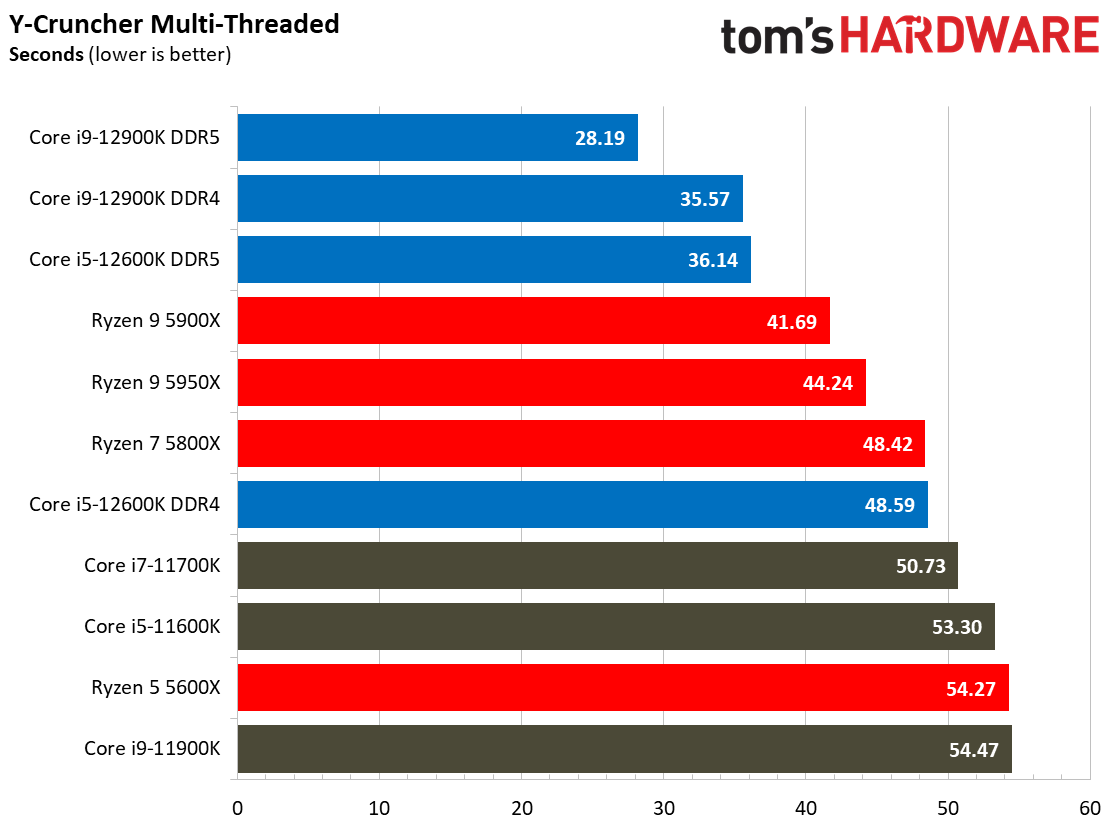
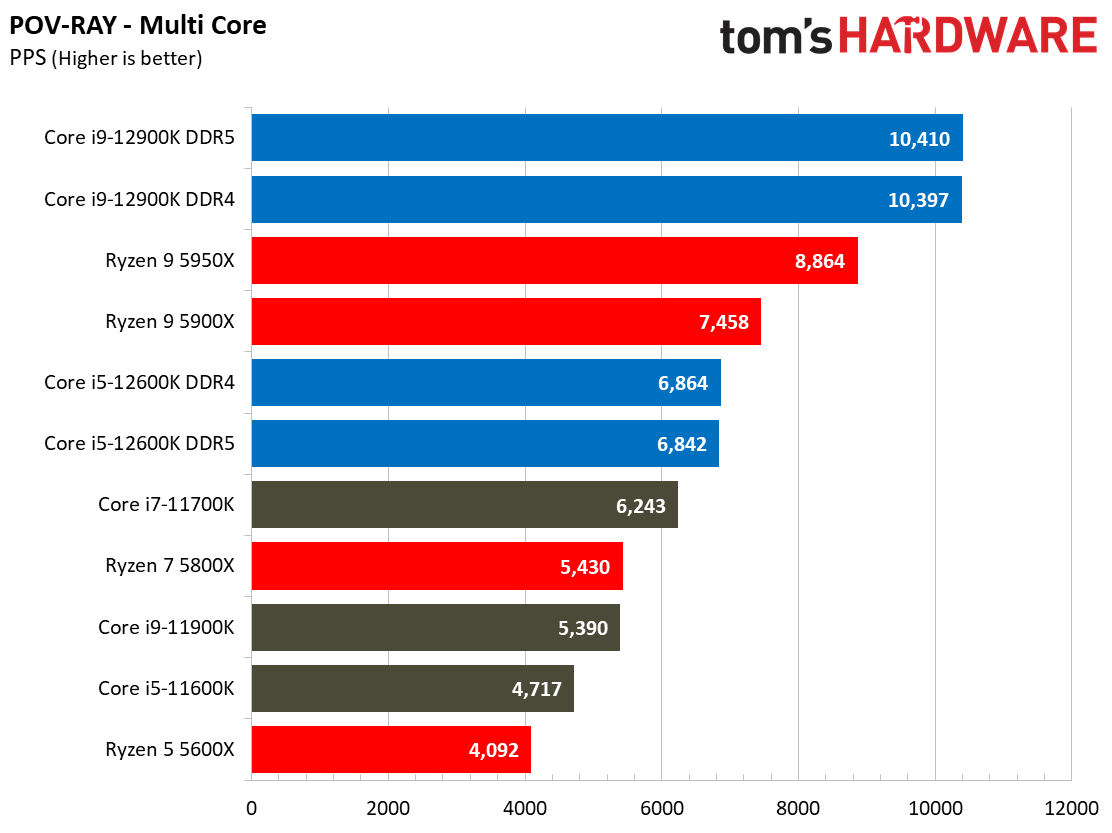

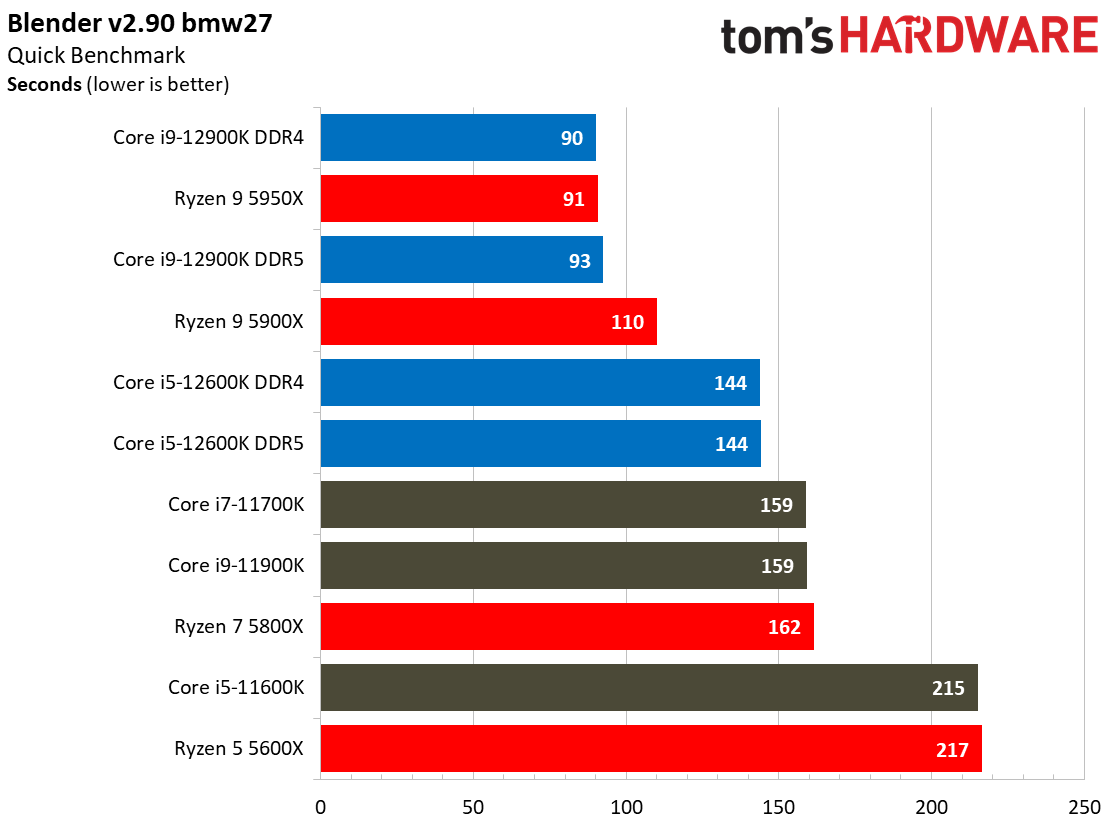




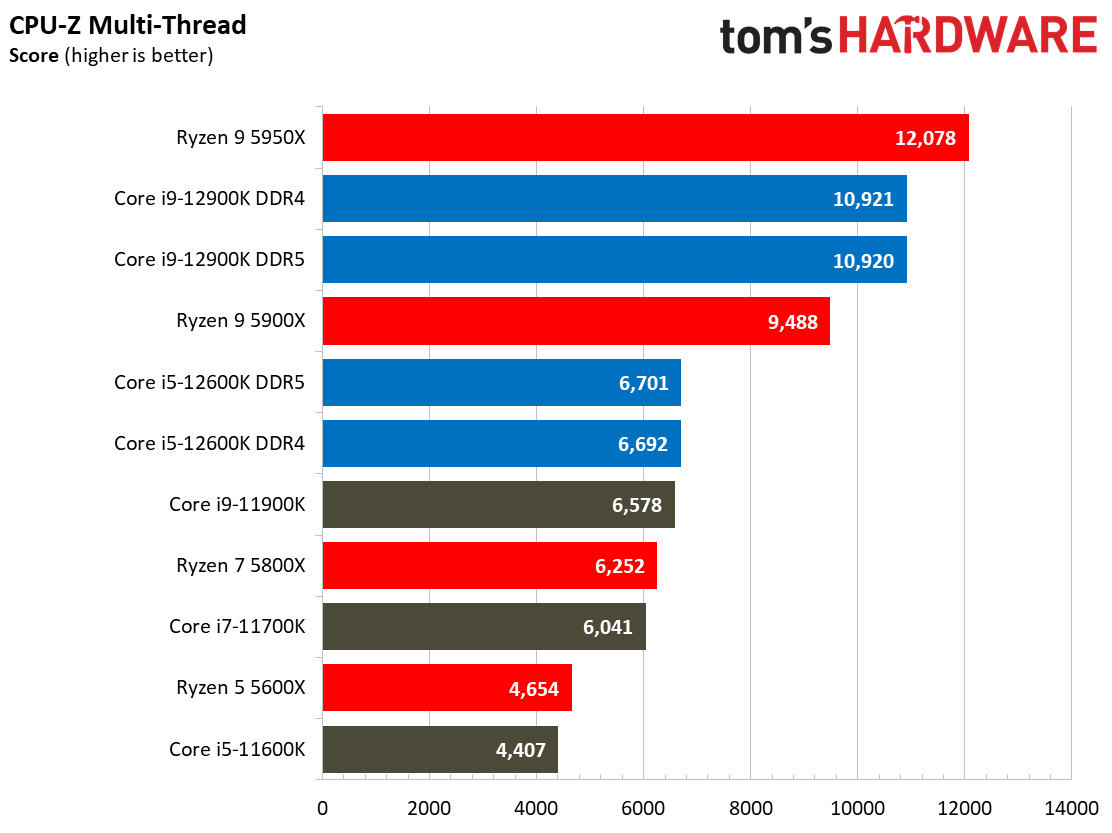
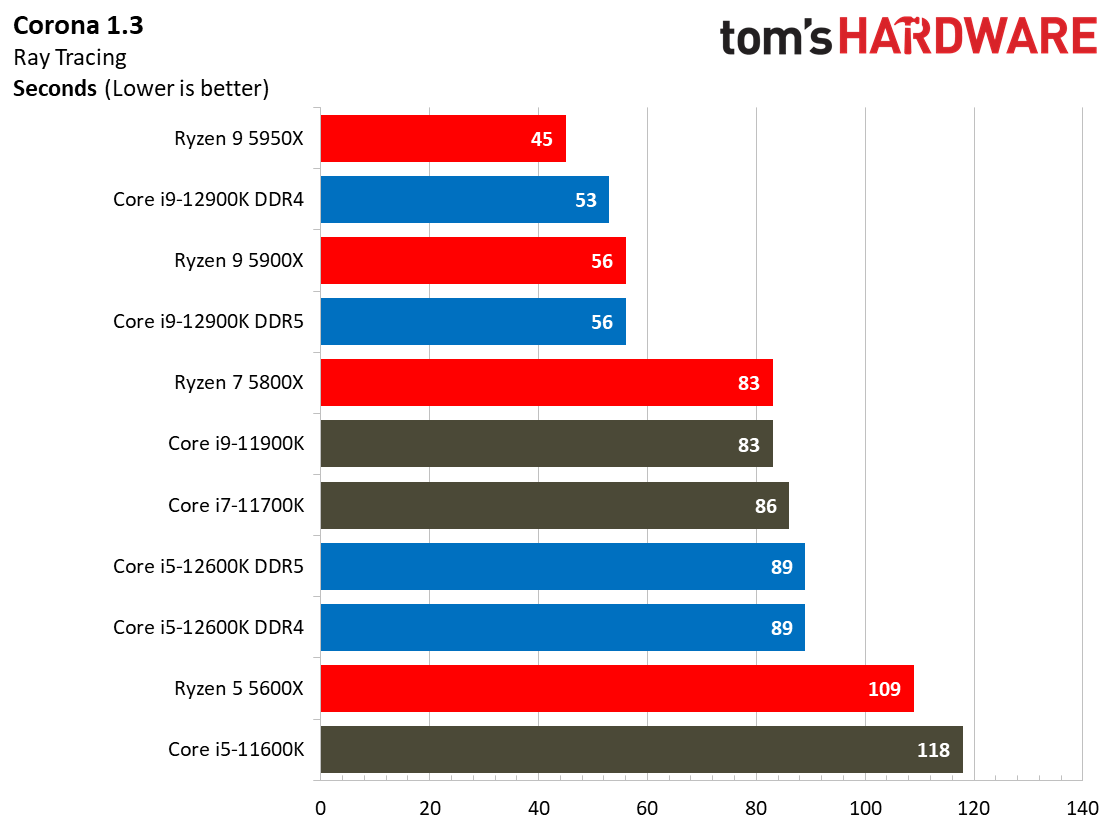

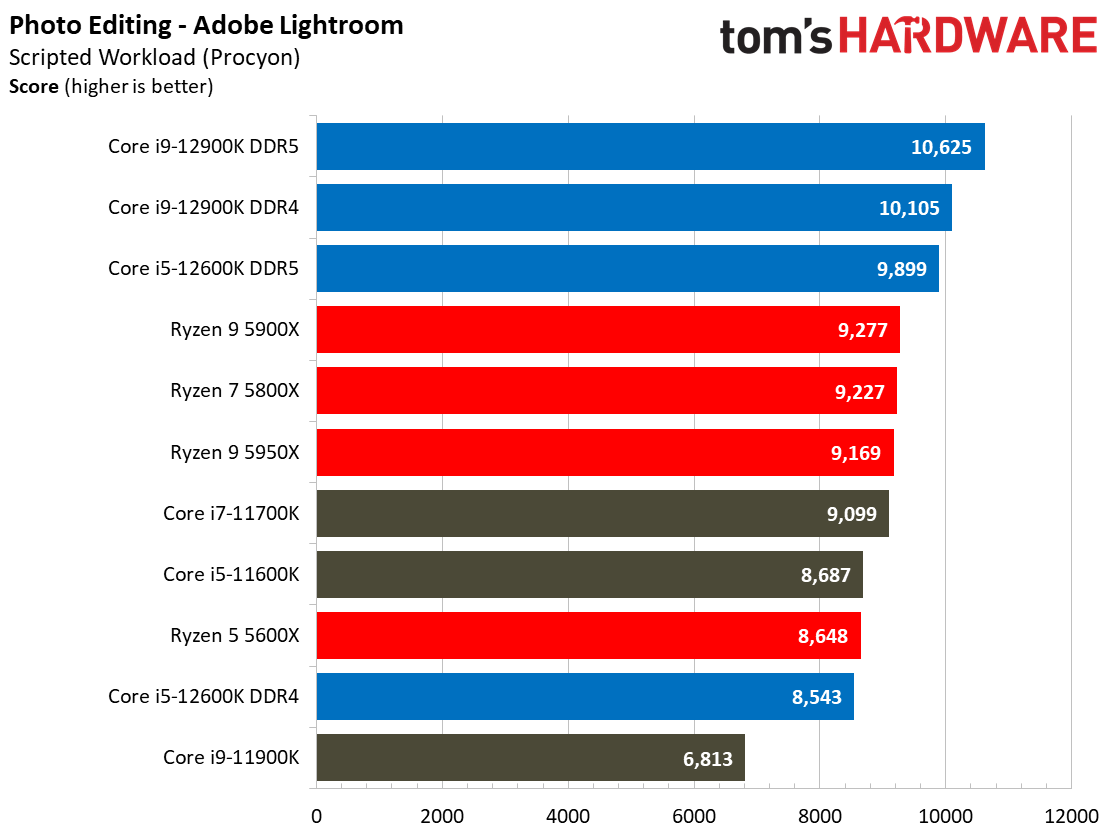

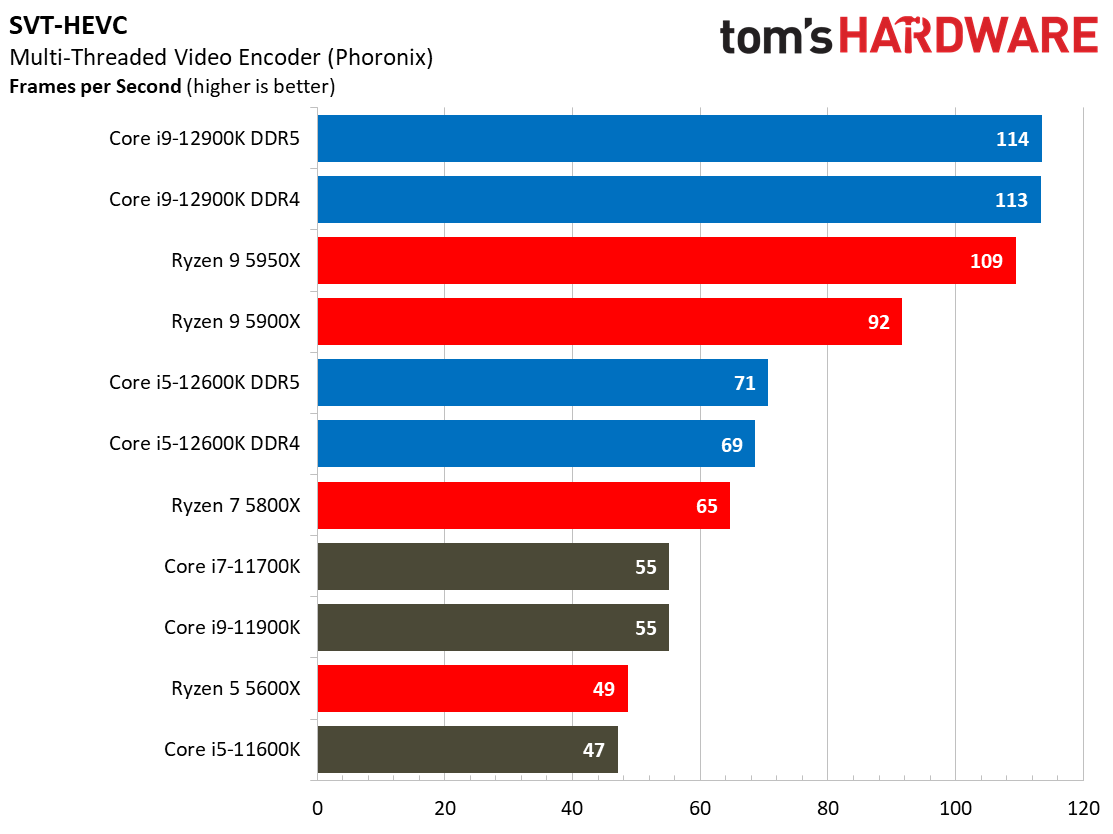
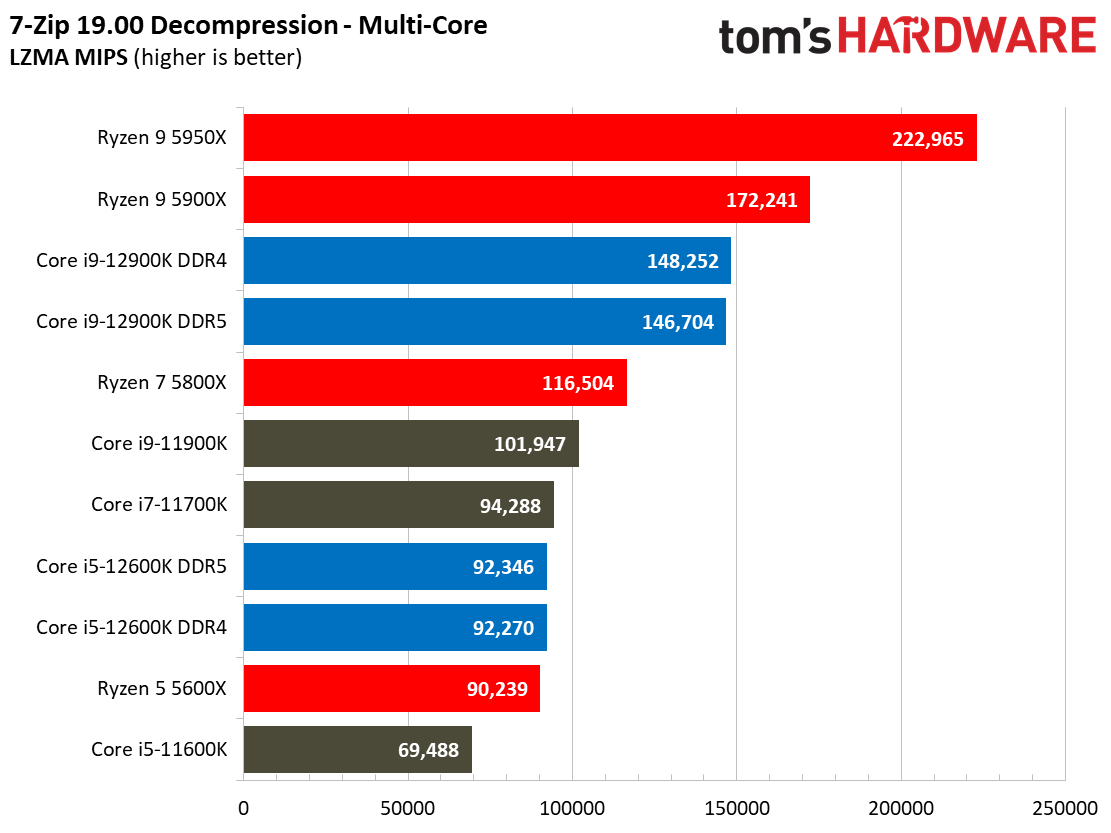
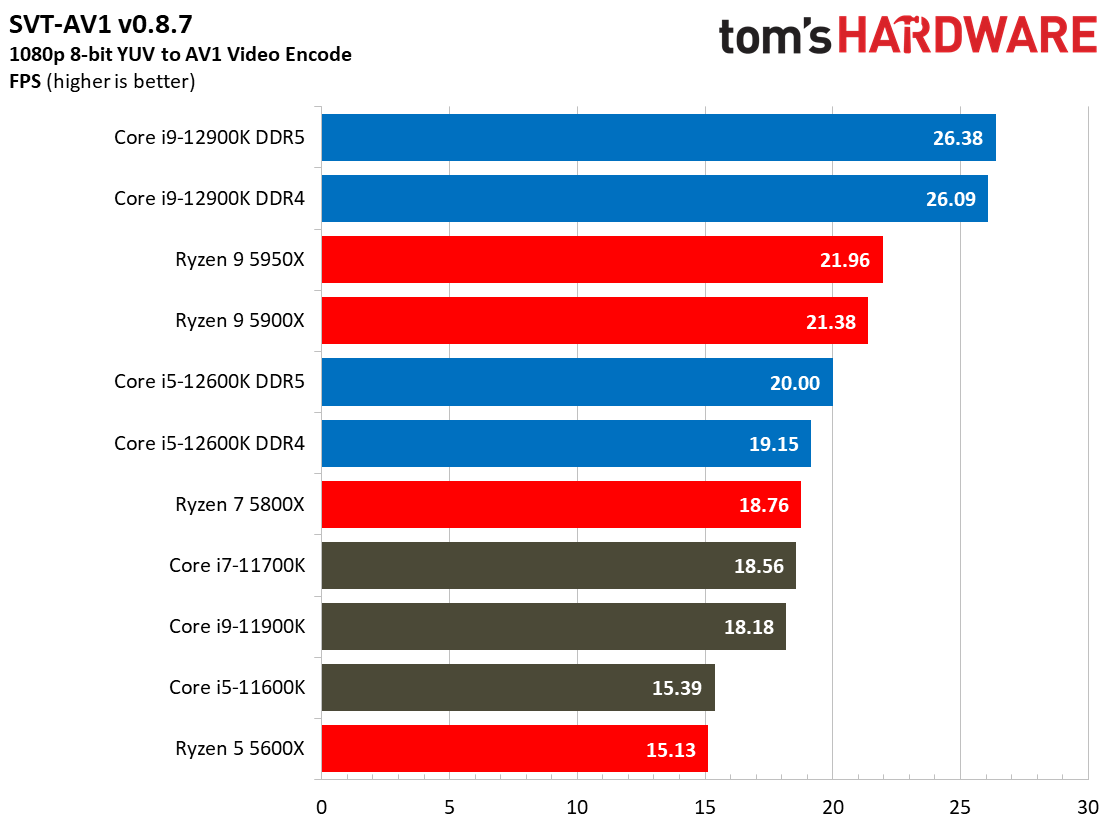
Intel clung to its single-threaded advantage for several chip generations as Ryzen destroyed it in threaded work and then slowly took the lead in single-threaded performance, too. Now that Intel has regained the single-threaded lead quite convincingly, the onus is on the company to retake the threaded crown in the lower price ranges.
The Core i5-12600K succeeds in that mission. Overall, the chip is an incredible 38% faster than the 5600X in threaded work, and 7% faster than the Ryzen 7 5800X. That 7% might not sound very impressive, but bear in mind that the 5800X costs $100 more than the 5600X — and that's when the 5800X is on sale.
Flipping through the album finds the 12600K beating the Ryzen 5 5600X in every threaded benchmark, while the Ryzen 7 5800X scored slight wins in one Blender render, v-ray, and Corona. We also see the 5800X edge past the 12600K with DDR4 memory in y-cruncher and Adobe Lightroom, but DDR5 gives the 12600K the lead in both of those tests.
Overall, it's quite impressive to see the sheer amount of threaded heft unleashed from the 10-core 12600K, especially in the exceedingly branchy code in the LLVM compilation workload and the massively parallel molecular dynamics simulation code in NAMD. These heavily-parallelized high-throughput applications respond very well to the E-cores. The 12600K also shines in more standard fare, like threaded encoding tasks, like Handbrake x264 and x265, SVT-HEVC, and SVT-AV1.
Winner: Intel
The Core i5-12600K wins in nearly every single-threaded benchmark, meaning the chip will deliver exceedingly snappy performance with many of the lighter types of work, like web browsers and office applications. At its price point, the 12600K is untouchable for this type of work.
The 12600K also beat the Ryzen 5 5600X in every multi-threaded workload, it really wasn't a contest at all, but the Ryzen 7 5800X put up more of a fight. However, given the 5800X's sale pricing, which is still $100 more expensive than the 12600K, those few narrow wins aren't worth the pricing delta.
The 12600K's superior blend of both single-and multi-threaded performance creates quite the compelling chip, especially given its price point. However, it is noteworthy that the Core i5-12600K can suffer in some multi-threaded workloads in Windows 10 due to difficulties with code with certain prioritization settings. You can correct those issues either via command-line utilities or third-party software, like Process Lasso, and receive the full expected performance. We expect the industry to correct many of those issues over time. Still, it is important to know that Windows 10 could require additional handholding to extract the utmost performance from the Alder Lake processors.
Overclocking: Intel Core i5-12600K vs Ryzen 5 5600X and Ryzen 7 5800X
Overclocking has become a lot more complex with the addition of a myriad of new knobs to turn, and much of that has to do with the shrinking frequency headroom. Over the last few years, both Intel and AMD have rolled more of their frequency headroom right into the stock settings, a byproduct of fierce competition. Luckily for mid-range system builders, you tend to find the most headroom in mid-range parts, like the Core i5-12600K and Ryzen 5 5600X. Enthusiasts have also turned to wringing out extra bits of performance from memory and fabrics as the companies expose more tuning knobs.
Both Intel and AMD expose a wealth of tunable parameters, along with sophisticated software overclocking utilities like XTU and Ryzen Master. Both companies also support per-core frequency and hyper-threading control (enable/disable) to help eke out more overclocking headroom.
Intel's Dynamic Memory Boost adds a new wrinkle. This new tech works with both DDR4 and DDR5 and allows the system to dynamically switch between standard memory frequencies and timings and an XMP profile, meaning that it will auto-overclock the memory as needed based on the current usage pattern. And yes, this occurs while the operating system is running and doesn't require a reboot — it's a real-time dynamic adjustment. Intel also continues to support its existing mechanism for live memory timing adjustments from within the operating system, giving users a plethora of on-the-fly memory overclocking options.
Intel has long locked overclocking to its pricey K-series models, while AMD freely allows overclocking with all SKUs on almost any platform. However, we see signs of some improvement here from Intel, as it has now enabled memory overclocking on its B- and H-series chipsets with the 500-series chipsets, and it appears that the same policy will hold true with the 600 series.
AMD's Ryzen 5000 chips come with innovative boost technology that largely consumes most of the available frequency headroom, so as we see with Intel's flagship, there is precious little room for bleeding-edge clock rates. In fact, all-core overclocking with AMD's chips is lackluster; you're often better off using its auto-overclocking Precision Boost Overdrive 2 (PBO2) feature that boosts multi-threaded performance. AMD also has plenty of Curve Optimization features that leverage undervolting to increase boost activity.
Intel generally has higher attainable peak frequencies, while AMD's more adaptive auto-overclocking tends to have less headroom. However, it's always important to remember that chip quality can vary for both vendors, so the silicon lottery always comes into play.
Winner: Tie
Both platforms have a wealth of tunable parameters for enthusiasts, their respective overclocking advantages, and a suite of both auto-overclocking and software utilities. However, there's still room for a sizeable performance boost from overclocking the core, fabric, and memory, so this contest will often boil down to personal preference.
Power Consumption, Efficiency, and Cooling: Intel Core i5-12600K vs Ryzen 5 5600X and Ryzen 7 5800X
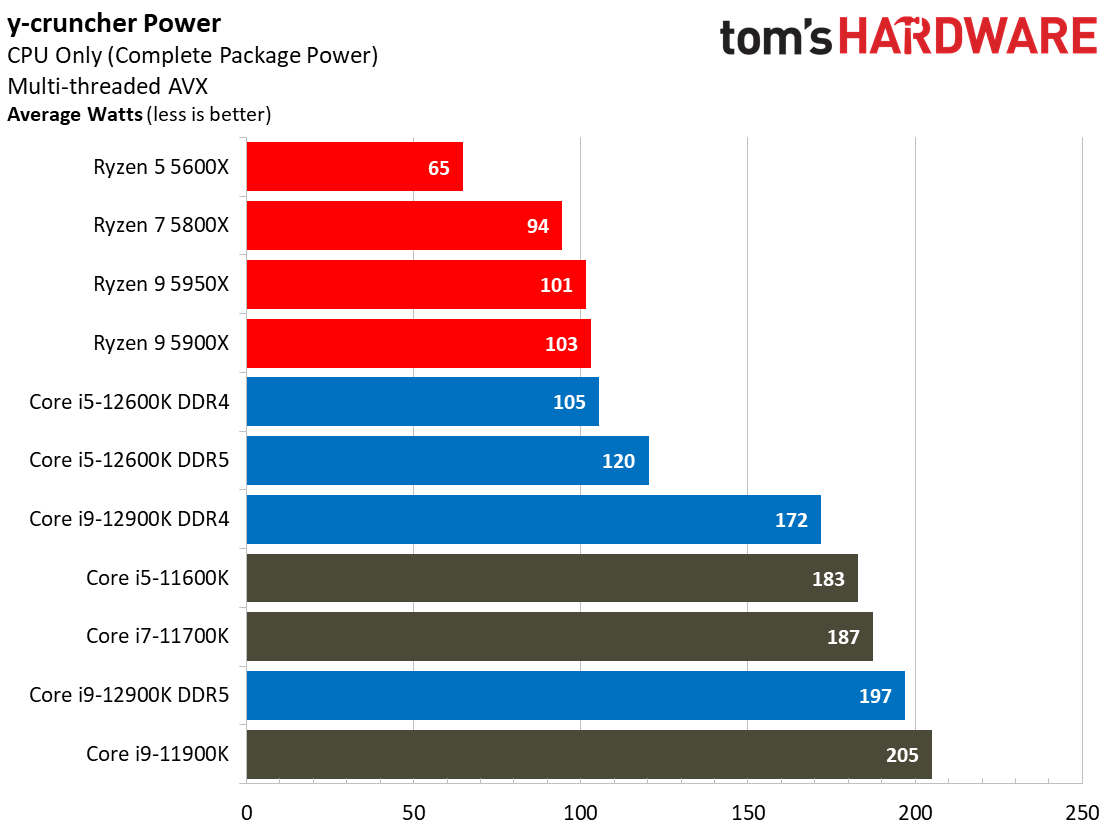
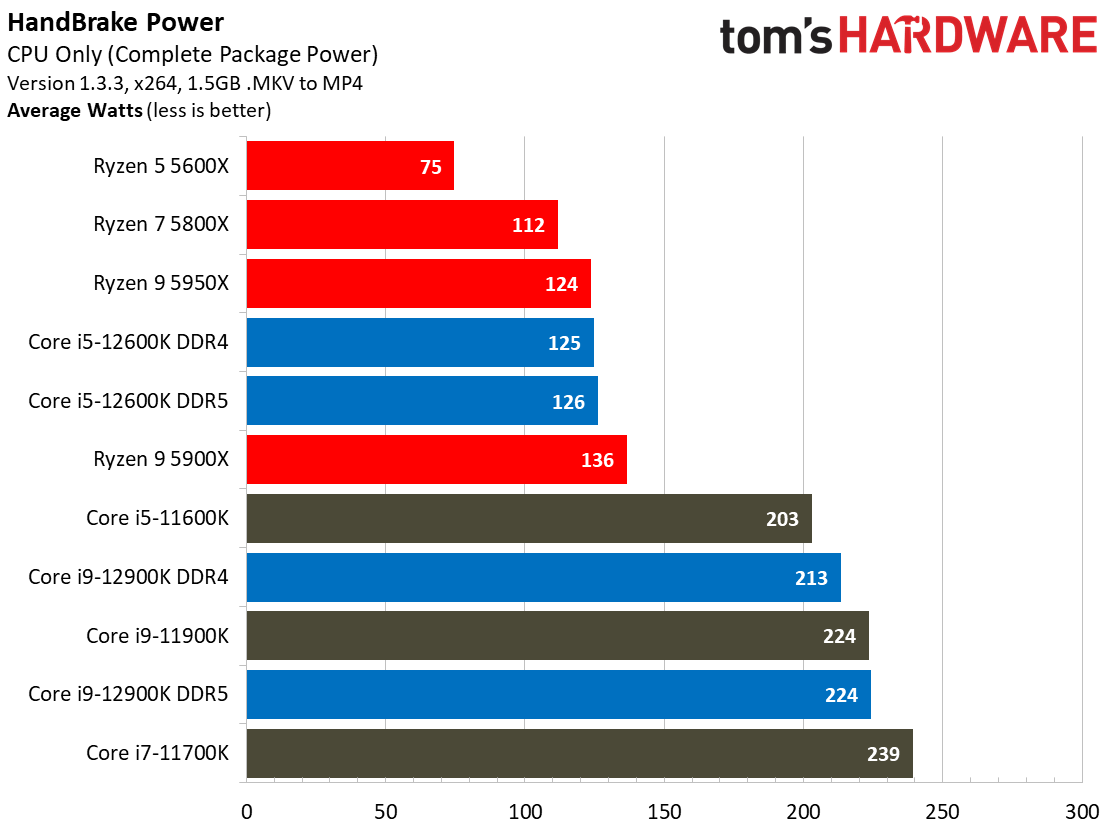



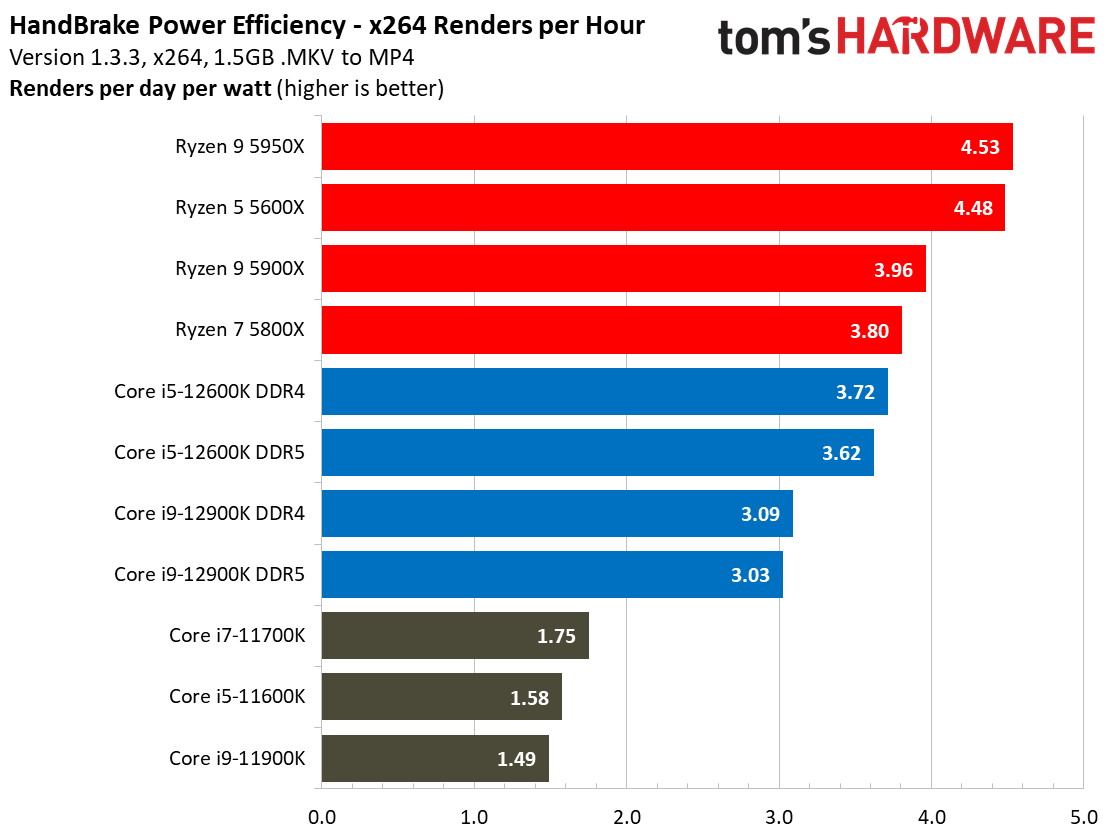
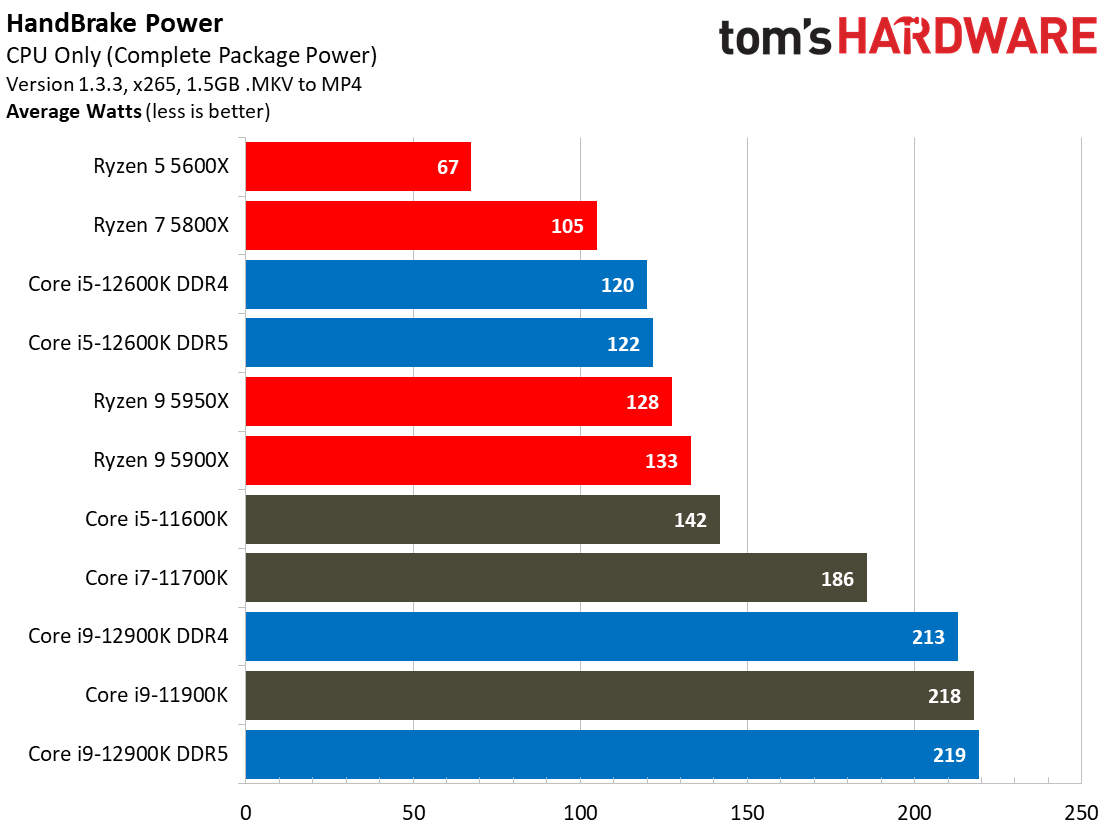
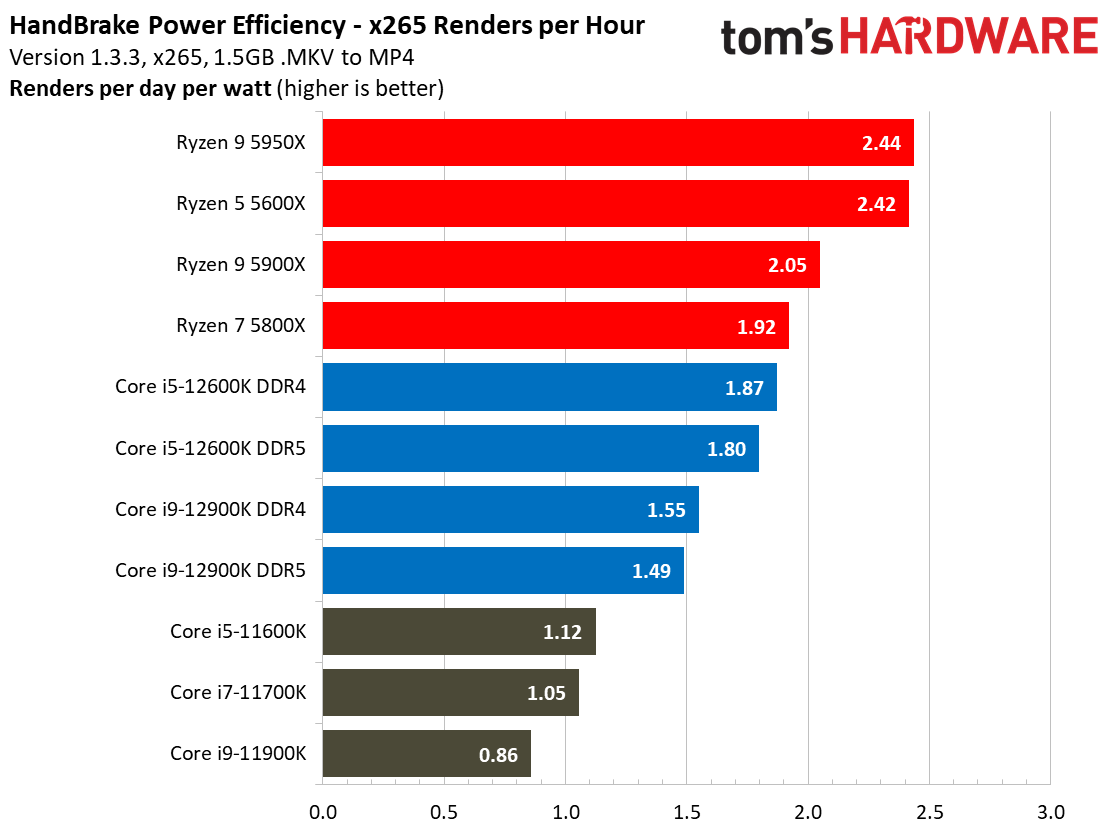
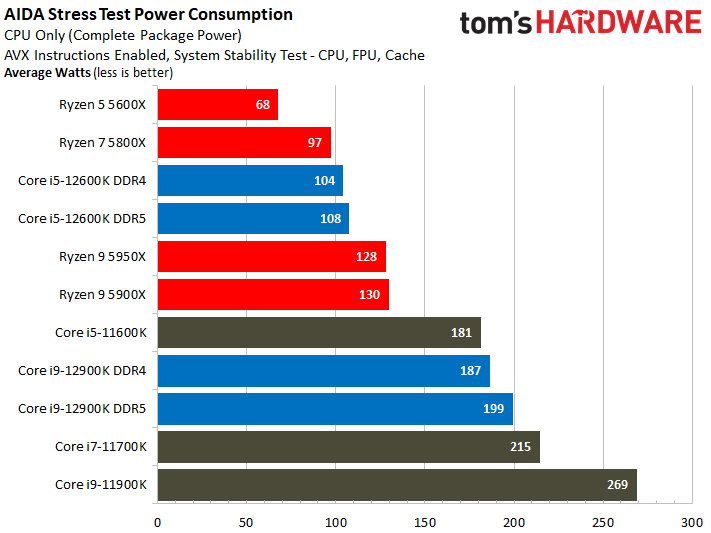
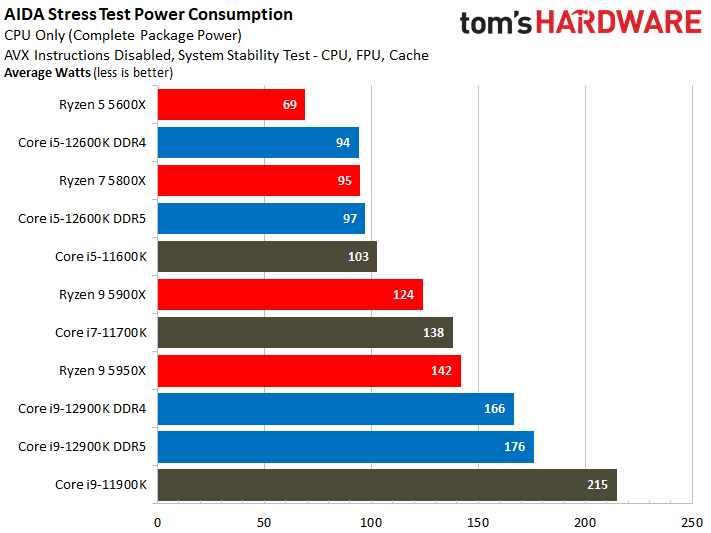




Intel's Alder Lake marks a much-needed drastic improvement to the company's power consumption and efficiency metrics. Those improvements come not only from the new architecture that shuffles heavily-threaded work to smaller, more efficient cores but also the new Intel 7 process that reduces power consumption and improves efficiency. As a result, the Core i5-12600K is far more power-efficient, meaning it draws less power for each unit of work done, than its predecessor.
The Ryzen 5 5600X remains one of the most power-efficient chips we've ever tested, and Alder Lake still sucks more power than AMD's Ryzen 5000 series chips. However, the Intel 7 process marks a big improvement over the old power-guzzling 14nm Rocket Lake chips — we measured a peak of 135W with the 12600K, while the previous-gen 11600K peaked at 203W.
Peak power consumption isn't the end-all-be-all, though. The Core i5-12600K is also much faster than its predecessor, earning it some leeway. As you can see in our renders-per-day measurements, the Core i5-12600K is roughly twice as efficient as the 11600K.
Overall, Intel has reduced its power consumption from meme-worthy to an acceptable level. The Core i5-12600K ran just fine with our 280mm liquid cooler, but you could get away with a 240mm or equivalent air cooler and still get the full performance.
The last four slides in the above album give us a different view of power efficiency. Here we calculate the cumulative amount of energy required to perform a given task. We plot this 'task energy' value in Kilojoules on the left side of the chart. These workloads are comprised of a fixed amount of work, so we can plot the task energy against the time required to finish the job (bottom axis) to give us a better look at efficiency.
Bear in mind that faster completion times and lower task energy are ideal. That means processors that are closest to the bottom left corner are best. It's easy to see that Intel has made a massive generational improvement here; the Core i5-11600K serves as quite the contrast to the 12600K.
However, AMD still holds the advantage in all of the key power criteria, with the Ryzen 5000 models retaining the crown of the most efficient desktop CPUs that we've ever tested.
Winner: AMD
Intel has made plenty of progress, but AMD still holds the crown of the most power-efficient chips. The Ryzen 5000 chips consume less peak power and also accomplish more work per unit of power consumed. That results in a clean sweep in power consumption, efficiency, and thermal output, so you'll end up with a cooler and quieter system.
Pricing: Intel Core i5-12600K vs Ryzen 5 5600X and Ryzen 7 5800X
Given the performance we've seen in our testing, the Core i5-12600K lands with an amenable $289 price tag. You can also snag the $264 graphics-less Core i5-12600KF for $25 less. The 12600K destroys the $299 Ryzen 5 5600X in every meaningful performance metric and beats the $390 Ryzen 7 5800X in most workloads.
However, the CPU is but one factor in the equation — you also need a motherboard and memory. Naturally, DDR5 memory is the elephant in the room, but that is pretty simple: You should expect to pay a massive early adopter premium for DDR5 memory, and more for the higher-end DDR5 motherboards. If you plan on going the DDR5 route, be ready to open your wallet wide — DDR5 memory is mostly out of stock or up to 50% more expensive than DDR4. If you're looking for bang-for-the-buck, DDR5 is off the table for now. Besides, we're not sure that DDR5 makes sense for this class of chip. Luckily, DDR4 offers nearly the same performance in most applications and faster gaming performance in Windows 10 (at least in our test environment).
Core i5-12600K systems will be built on Z690 motherboards for now, as Intel hasn't released the B- or H-series chipsets yet. That's particularly painful in this chip price class. In addition, all high-end Z690 motherboards support DDR5, but most (if not all) of the DDR4-compatible Z690 boards land in the lower- to mid-ranges of the Z690 stack.
For now, if you're looking to build a Ryzen 5 5600X system on a B- or A-series chipset, you'll have a lower overall platform cost than you'll see with the 12600K. We expect the pricing delta to decline significantly when Intel releases its own H- and B-series chipsets. However, the Ryzen 7 5800X's higher price point means you'll still pay more for a system built with that chip.
We can make a few comparisons with X570 and Z690 boards, though. It's still a bit early to get the complete picture on motherboard pricing; we're seeing the normal spotty availability in the wake of a big launch. Here are a few like-for-like comparisons, but this could vary (pricing is valid only at the time of publication):
| Row 0 - Cell 0 | Price |
| MSI PRO Z690-A DDR4 | $239 |
| MSI X570-A PRO | $153 |
| ASRock Z690 Phantom Gaming 4 | $180 |
| ASRock X570 PHANTOM GAMING 4 | $154 |
| ASUS Prime Z690-P D4 | $220 |
| ASUS PRIME X570-P | $160 |
As you can see, we're looking at price deltas that range from $26 to $86 between the X570 and Z690 DDR4 motherboards, with the latter being more expensive. Of course, you'll have to add in those costs if you plan to build around the 12600K.
However, there are a lot of factors in play. While you will pay more for a DDR4-equipped 12600K system than you would with the Ryzen 5 5600X, you get 5% faster gaming performance, 21% faster performance in single-threaded work, and 38% more performance in multi-threaded applications. Additionally, the Z690 platform offers more robust connectivity options.
Winner: Tie
Intel Core i5-12600K systems outfitted with DDR5 memory will come at a big premium that might not be worth the slim performance gains over DDR4 in most applications, especially with Alder Lake chips with lower core counts. Given the early state of DDR5 availability, it's hard to nail down firm estimates. However, the high pricing of DDR5 isn't worth it for most users, which removes one of the key reasons to go with an Alder Lake system.
Suppose you're building around a DDR4-based system. In that case, a Ryzen 5 5600X system will come in at considerably lower pricing if you opt for B- and H-series chipsets that aren't available yet for the 12600K, but the Alder Lake platform provides more than enough extra performance and connectivity to justify the price tag. The Ryzen 7 5800X is also competitive here, but its higher chip pricing means that platform costs could equate to a wash, giving the nod to the 12600K due to its faster performance and superior connectivity.
Bottom Line: Intel Core i5-12600K vs Ryzen 5 5600X and Ryzen 7 5800X
| Row 0 - Cell 0 | Intel Core i5-12600K | AMD Ryzen 5 5600X and 5800X |
| Features and Specifications | X | Row 1 - Cell 2 |
| Gaming | X | Row 2 - Cell 2 |
| Application Performance | X | Row 3 - Cell 2 |
| Overclocking | X | X |
| Power Consumption, Efficiency, and Cooling | Row 5 - Cell 1 | X |
| Pricing | X | X |
| Total | 5 | 3 |
The Core i5-12600K vs Ryzen 5 5600X and Ryzen 7 5800X battle ends in a five to three win in Intel's favor, with much of that advantage coming from the 12600K's outstanding performance for its price point.
In performance testing, the $289 Core i5-12600K beat the $299 Ryzen 5 5600X in every meaningful test by large margins, with 5% faster gaming performance, 21% faster performance in single-threaded work, and 38% more performance in multi-threaded applications. That makes for an incredibly well-balanced system.
Additionally, even though the ~$390 Ryzen 7 5800X is ~$100 more than the 12600K, the Alder Lake chip was 3% faster in gaming, 15% faster in single-threaded work, and 7% faster in multi-threaded productivity applications. Yes, the Ryzen 7 5800X beats the Core i5-12600K in a few threaded tasks, but by comparatively slim deltas given its higher pricing.
With DDR4, the Core i5-12600K is the fastest gaming chip in its price bracket in both Windows 10 or 11, but it does lose some steam with DDR5 on Windows 10. AMD will fire back with its 3D V-Cache processors that will come with up to 192MB of L3 cache per chip, which the company says imparts up to 15% more gaming performance. Those chips arrive next year, but the impact on gaming beyond eSports titles is unknown.
The Core i5-12600K's advantages also include platform additives, but the DDR5 and PCIe 5.0 interfaces add cost to the overall picture. Support for DDR4 can help reduce that premium, but we haven't seen any flagship DDR4 motherboards yet; the highest-end models appear to be confined to DDR5. If you're going with a DDR5 build, prepare yourself for eye-watering pricing, at least until supply improves. Luckily, you won't need expensive DDR5 memory to unlock the best gaming performance — unless you have a very specific need for DDR5, it's probably best to skip it until it matures further.
But even lower-end Z690 platforms don't make the best sense with the 12600K. Intel needs to solidify the 12600K's value prop with B- and H-series motherboards, but they aren't on the market yet. Intel's decision to launch with only the Z690 series leaves some pathways to less expensive Ryzen 5 5600X systems with a pretty competitive price-to-performance ratio. If you're on a budget, you can still find great motherboard deals on B-series AMD boards that will be perfectly serviceable if you aren't after the absolute best performance. We could also see price cuts for the Ryzen 5 5600X in the future.
That means that while Intel has delivered a staggering blow on the performance front, it has deferred the Ryzen 5 5600X's complete execution by delaying its own B- and H-series boards. That said, Intel's competitive chip pricing does take some of the sting out of the high platform costs.
AMD still holds the power and efficiency crown, but the 12600K's 'Intel 7' process reduces peak power consumption by up to 33% and roughly doubles power efficiency, reducing AMD's overwhelming lead. Overall, if we take performance into account, Intel has reduced its power consumption from meme-worthy to an acceptable level.
Software updates should help resolve many of the early issues in Windows 10, but you might need to engage in some manual tweaking for the 12600K with some specific programs. However, despite those early hiccups with Windows 10, Intel's gamble to adopt a hybrid x86 architecture has clearly paid off.
Overall, Alder Lake marks a massive generational leap forward, allowing the 12600K to lead its price class in all performance metrics, like gaming and lightly- and heavily-threaded work, while also punching up against the more expensive Ryzen 7 5800X in incredibly convincing fashion.
Whip in the improved power consumption and efficiency, cutting-edge platform connectivity options, and aggressive chip pricing, and the Core i5-12600K wins the faceoff with the Ryzen 5 5600X and the Ryzen 7 5800X.
- MORE: Best CPUs for Gaming
- MORE: CPU Benchmark Hierarchy
- MORE: AMD vs Intel
- MORE: All CPUs Content
| Intel Socket 1700 DDR5 (Z690) | Core i9-12900K, Core i5-12600K |
| Row 1 - Cell 0 | MSI Z690 Carbon WiFi |
| Row 2 - Cell 0 | 2 x16GB G.Skill Ripjaws S5, DDR5-5200 @ DDR5-4400 36-36-36-72 |
| Intel Socket 1700 DDR4 (Z690) | Core i9-12900K, Core i5-12600K |
| Row 4 - Cell 0 | MSI Z690A WiFi DDR4 |
| Row 5 - Cell 0 | 2x 8GB Trident Z Royal DDR4-3600 - Stock: DDR4-3200 14-14-14-36 |
| Intel Socket 1200 (Z590) | Core i9-11900K, Core i7-11700K, Core i5-10600K |
| Row 7 - Cell 0 | MSI Z590 Godlike |
| Row 8 - Cell 0 | 2x 8GB Trident Z Royal DDR4-3600 - Stock DDR4-3200/2933 Gear 1 |
| AMD Socket AM4 (X570) | AMD Ryzen 9 5950X, Ryzen 9 5900X, Ryzen 7 5800X, Ryzen 5 5600X |
| MSI MEG X570 Godlike | |
| Row 11 - Cell 0 | 2x 8GB Trident Z Royal DDR4-3600 - Stock: DDR4-3200 14-14-14-36 |
| All Systems | Gigabyte GeForce RTX 3090 Eagle - Gaming and ProViz applications |
| Row 13 - Cell 0 | Nvidia GeForce RTX 2080 Ti FE - Application tests |
| 2TB Intel DC4510 SSD | |
| Silverstone ST1100-TI | |
| Row 16 - Cell 0 | Open Benchtable |
| Windows 10 Pro version 2004 (build 19041.450) | |
| Row 18 - Cell 0 | Windows 11 Pro version |
| Cooling | Corsair H115i |

Paul Alcorn is the Editor-in-Chief for Tom's Hardware US. He also writes news and reviews on CPUs, storage, and enterprise hardware.
-
octavecode In my humble opinion the article is missleading.Reply
First of Windows 11 don't like ryzen very much even after al those patches.
12600k is 10core cpu and delivers around 10% more performance in games with close to double power consumption compared to 5600x and also in my country 30eu more expensive than ryzen plus a way more expensive motherboard.
I fail to see Intel as a winner here tbh , don't get me wront intel has a new core design that is powerfull
but it's expensive and power consumption still sucks -
mamasan2000 Replyoctavecode said:In my humble opinion the article is missleading.
First of Windows 11 don't like ryzen very much even after al those patches.
12600k is 10core cpu and delivers around 10% more performance in games with close to double power consumption compared to 5600x and also in my country 30eu more expensive than ryzen plus a way more expensive motherboard.
I fail to see Intel as a winner here tbh , don't get me wront intel has a new core design that is powerfull
but it's expensive and power consumption still sucks
Avg fps across all tests difference, 158 vs 151 = 7 fps. That is 5%. 15 fps would be 10%. Best of all, you wouldn't notice the difference unless you are running a monitoring program or benchmark to compare.
And that is at 1080p. At 1440p it is 3 fps. So 2%. That is very close to margin of error, I assume. So same performance at twice the power, I would know which one to get. Electricity isn't free. -
LolaGT In the unlocked CPU market gamers drive it almost exclusively.Reply
Anyone above the casual gamer will not care about the power consumption numbers.
Average gamers want the fastest for the least initial investment, and any gamer that would call themselves a PC gamer will care even less, they will want the fastest option they can afford in the games they play.
Intel has won for now, at least until the next gen AMD offering. -
Mattzun A comparison like this on a 12600k or 5600x is rather uselessReply
No one who has 2000$ (or more) to spend on a 3090 for gaming is getting either of those chips
I can see someone with that kind of money getting a 12900k for the slightly better single thread performance.
No one who has a business productivity need for multithreaded performance is going to get either of those chips.
The 12900k is an obvious choice for that as well
For more normal folks, trying to build on a budget and struggling to find any reasonably modern GPU for something around MSRP (say a 1660 to 3060), any reasonably modern CPU will be GPU limited
For these people, the sales on the 11400 and the proven, low cost motherboards and RAM are far more compelling options.
From the do you need a new CPU videos on other sites, there is no actual benefit for me upgrading my 2600x for 1440P gaming if I ever manage to buy a 3070. -
TerryLaze Reply
Because the 12600k is a 6 ( +4) core and beats the 12 core 5800x...octavecode said:In my humble opinion the article is missleading.
First of Windows 11 don't like ryzen very much even after al those patches.
12600k is 10core cpu and delivers around 10% more performance in games with close to double power consumption compared to 5600x and also in my country 30eu more expensive than ryzen plus a way more expensive motherboard.
I fail to see Intel as a winner here tbh , don't get me wront intel has a new core design that is powerfull
but it's expensive and power consumption still sucks
you are not supposed to compare it with the 5600x since it beats the next higher tier in everything gaming as well as productivity and only has about a 10% higher power draw than the 5800x as well.
It has the same price as the 5600x but beats the 5800x that is $150 more expensive.
The competition for the 5600x will probably be the 12400. -
helper800 Reply
After going through many of the benchmarks posted everywhere these are my conclusions. Ryzen performs within margin of error between Win 10 and Win 11, and so does intel. A decent kit of DDR4 performs marginally better or worse (+-2%) than DDR5 on intel regardless of OS. This notion that AMD is worse here or better there, as well as intel, is now not the case. What we can surmise from all the benchmarks is that the 12600k-12900k are about 7-9% faster than AMD processors in games and trade blows in production task with Intel edging out in the more commonly used applications (again usually within single digit percentages).octavecode said:In my humble opinion the article is missleading.
First of Windows 11 don't like ryzen very much even after al those patches.
12600k is 10core cpu and delivers around 10% more performance in games with close to double power consumption compared to 5600x and also in my country 30eu more expensive than ryzen plus a way more expensive motherboard.
I fail to see Intel as a winner here tbh , don't get me wront intel has a new core design that is powerfull
but it's expensive and power consumption still sucks
What does this mean for gaming? Well we have seen in benchmarks that at 1080p and somewhat 1440p with a 3090 GPU Intel is marginally faster as described above. With anything less than a 3090 as a GPU or anything more than 1080p as a resolution. this gap in performance will shrink to 1-5%.
The considerations that need to be made when buying a CPU for gaming right now;
What is the price of a 12600k/f/non-k or higher versus a 5600x -5950x?
What is the availability of Z690 motherboards, and DDR5?
Are any of your games affected by the DRM bug preventing playing it? This is a thing and there is a decent sized list of games you literally cannot play on Intel's 12000 series, and even if its not their fault (it isn't) it will be something you will have to deal with if you choose the 12000 series.
Do I want to use Win 11 for correct scheduler assignment (mainly power consumption related)?
Do I want to pay to be a beta tester for Intel, DDR5 support, motherboard manufacturers, and Microsoft, or any combination of the former?
There is also the question of power efficiency. This is a bit more controversial because all of the default and non-warranty breaking juicer options Intel lets their board partners set. Generally though if you do not touch BIOS options AMD is more power efficient. You can make Intel the same efficiency-wise as AMD by changing a few options and it will only lose you about 2-3% performance.
Intel has brought some competition to the CPU market after AMD brought it back after about 9 years of misery. This is good for everyone. In fact I had hoped Intel would gap AMD by 15-20% so they would have to respond in kind. But ~8% is still good enough, just less pressure than I had hoped. -
spongiemaster Reply
Not true. The problem is the E cores. Disabling the E cores fixes the issue. Intel released a workaround for this over a week ago, until the DRM software itself is fixed.helper800 said:Are any of your games affected by the DRM bug preventing playing it? This is a thing and there is a decent sized list of games you literally cannot play on Intel's 12000 series, and even if its not their fault (it isn't) it will be something you will have to deal with if you choose the 12000 series.
https://www.tomshardware.com/news/intel-offers-workaround-drm-issues
Power-up system and enter system BIOS setup.
Enable switch Legacy Game Compatibility Mode to ON (one-time only) in BIOS.
Save BIOS setup changes and exit.
Boot to OS.
Toggle Keyboard Scroll Lock key ON.
Launch affected game title.
Toggle Keyboard Scroll Lock key OFF after ending game titleAfter toggling the setting in the BIOS, having to hit the scroll lock key before and after playing certain games is really not a reason to not buy a CPU. -
Makaveli Reply
The 5800X is 8/16 unless that was a typo and you meant 5600X.TerryLaze said:Because the 12600k is a 6 ( +4) core and beats the 12 core 5800x...
you are not supposed to compare it with the 5600x since it beats the next higher tier in everything gaming as well as productivity and only has about a 10% higher power draw than the 5800x as well.
It has the same price as the 5600x but beats the 5800x that is $150 more expensive.
The competition for the 5600x will probably be the 12400.
if you look at reviews around the web the 12600k doesn't beat the 5800X across the board in gaming. And in productivity its close depending on the app. 10 cores vs 8 cores in that matchup gives the 12600k a slight edge but not always. -
-Fran- In the price comparison the Cooler wasn't included, where it is mentioned explicitly the 5600X comes with one and you don't need the X570 chipset to run neither a 5600X or 5800X. The pricing is not a tie and goes to AMD, even if by a slim margin. Whatever you save on the main components you can put down on a better GPU. Also, less power you can get away with a cheaper PSU and get a better GPU (well, big "if").Reply
In the features part, it's strange you talk about PCIe4 like it's a 20 year old piece of tech and DDR4 being render completely useless now. If you think it's better to use DDR5, but then don't take that into account for pricing, that's a huge misleading thing to do. If you think PCIe5 GPUs (because it's only for the GPU; NVMe uses PCIe4 links) are coming soon and they can actually make use of the extra bandwidth, then you could argue that, but I see no evidence PCIe5 is going to be a huge boost to GPUs in any way shape or form. These are just checked boxes that while "cool to have", are by no means "platform defining features". Specially when you can't even assess how much of a difference they make right now and assume they will in the future, where if you look back at history, they really don't (PCIe4 vs 5 for GPUs).
So, what gives?
Regards. -
Alvar "Miles" Udell I wouldn't say Ryzen has fallen, but that Intel is finally getting back on track, everyone knew they would eventually.Reply
These last few years have brought massive increases in performance which wouldn't have been had if AMD were still flailing about with uncompetitive (IPC wise) processors, and the HEDT space is thriving thanks to Threadripper. But the tradeoff is that with Intel flailing consumers have seen prices increase, so with AMD finally facing actual competition again, in some form at least, and the Intel badge still carrying a lot of weight, maybe us customers will finally start seeing a price war instead of our money filling AMD's coffers.